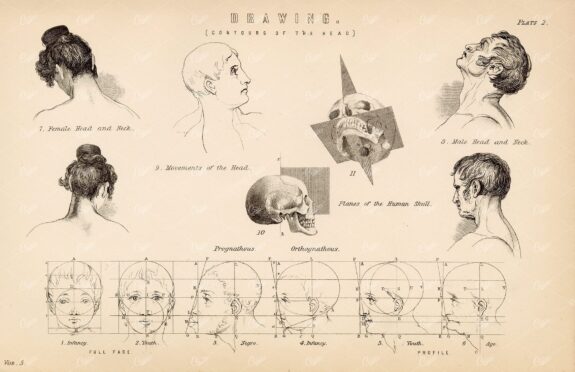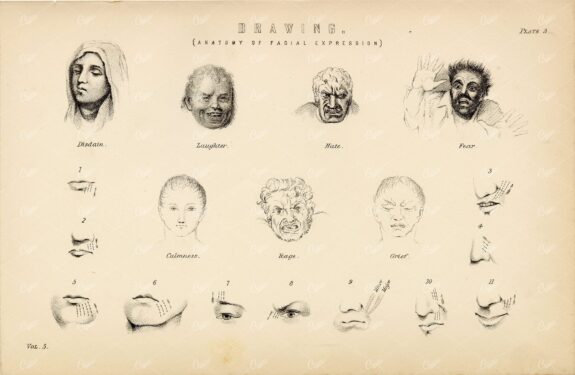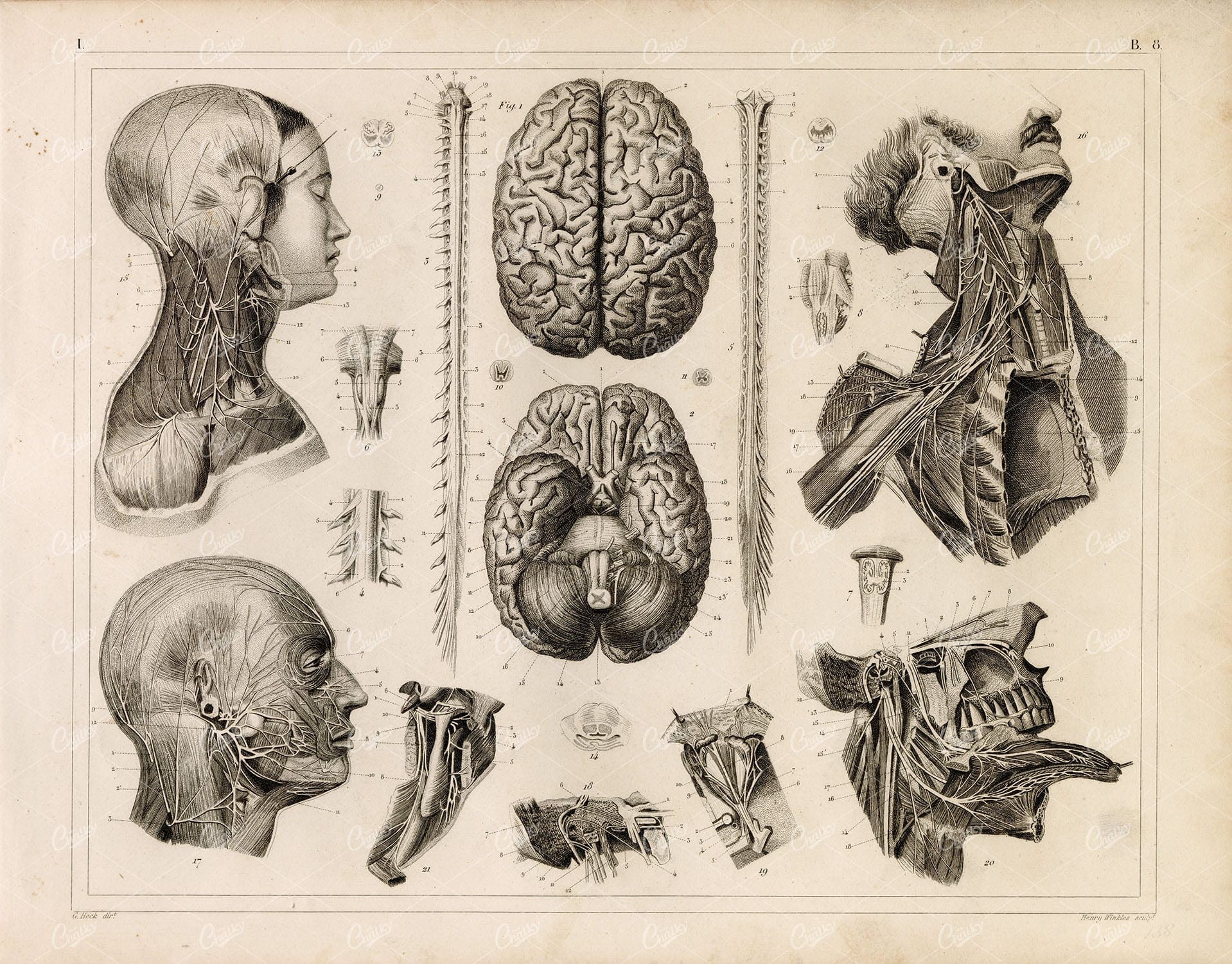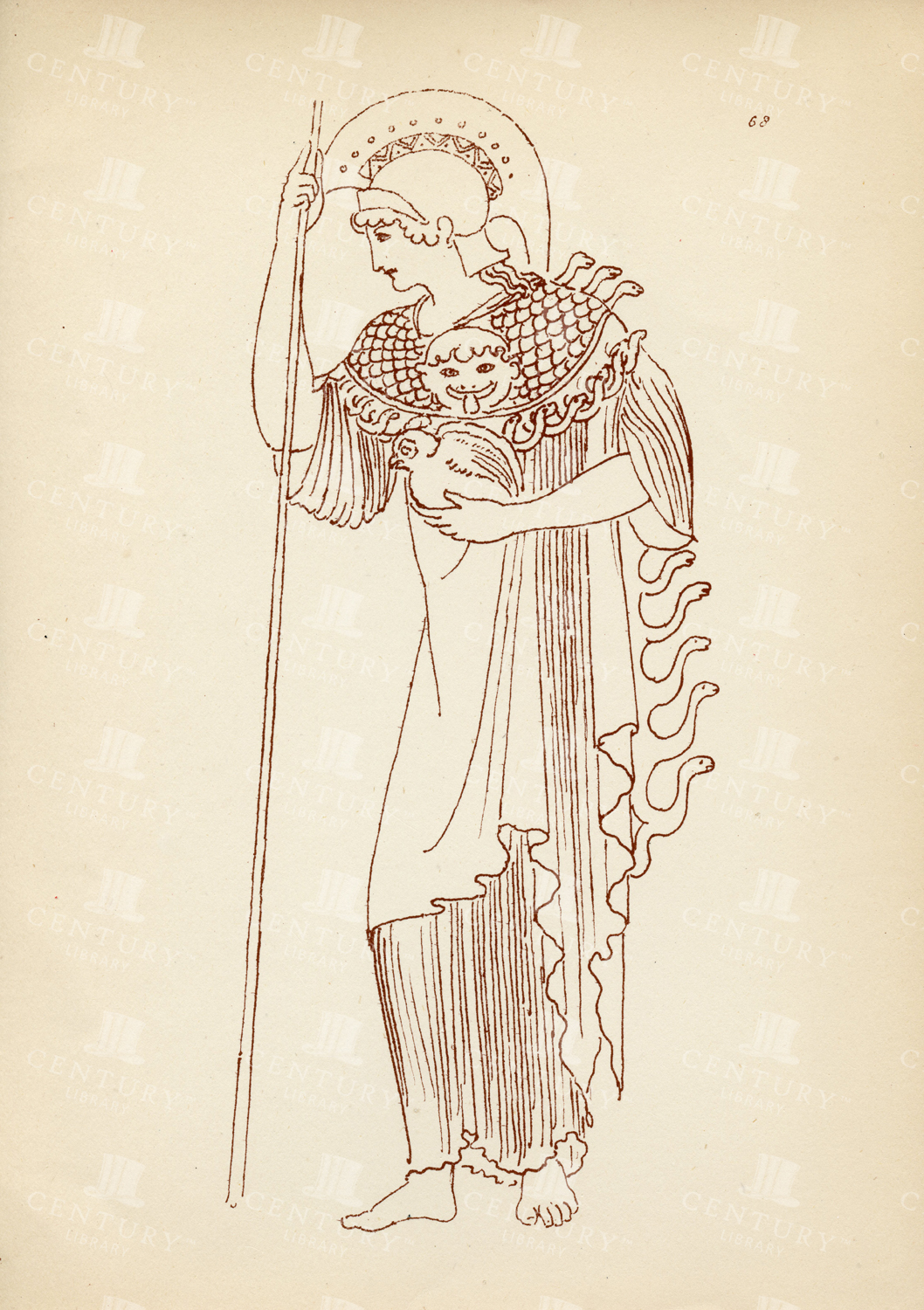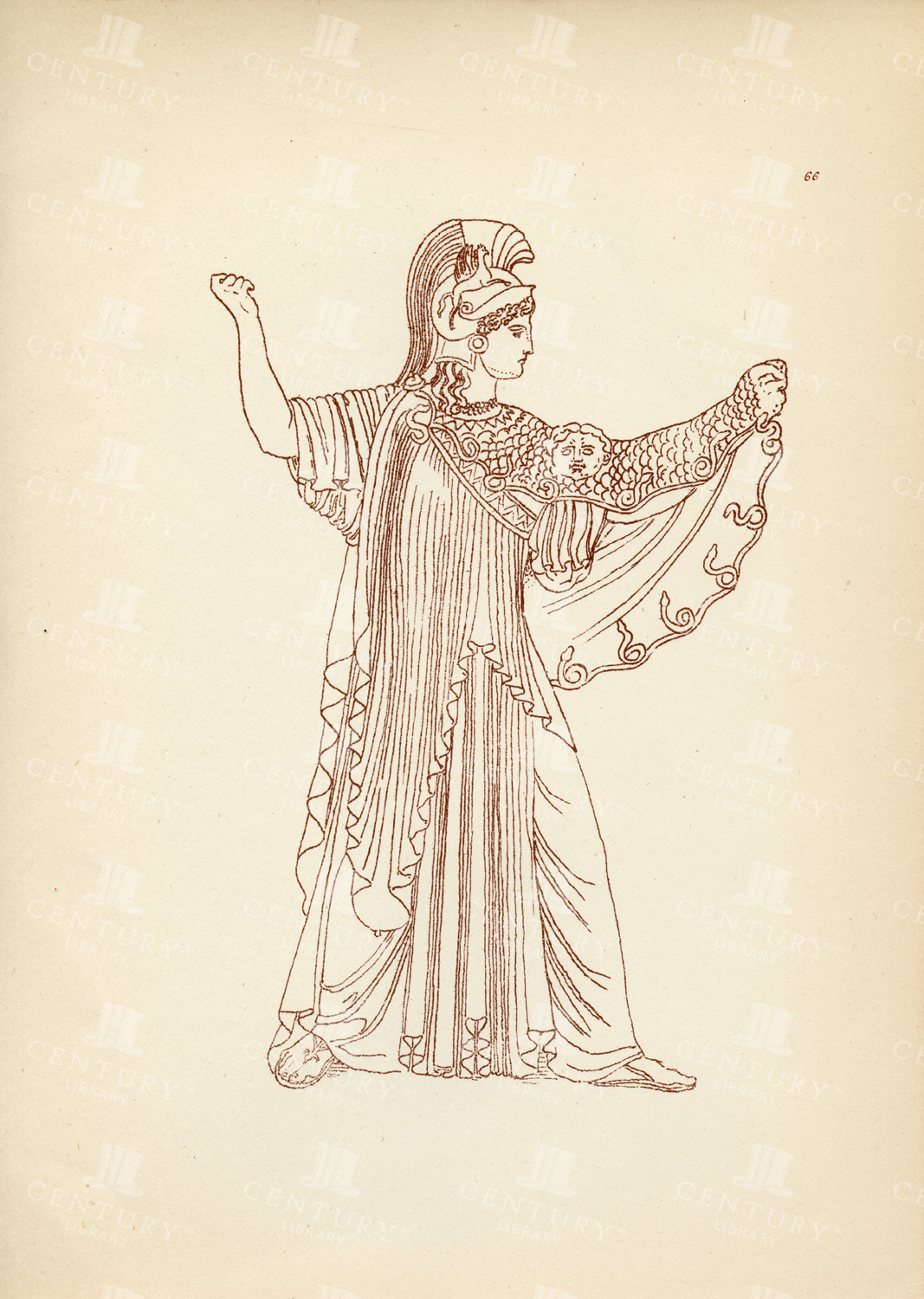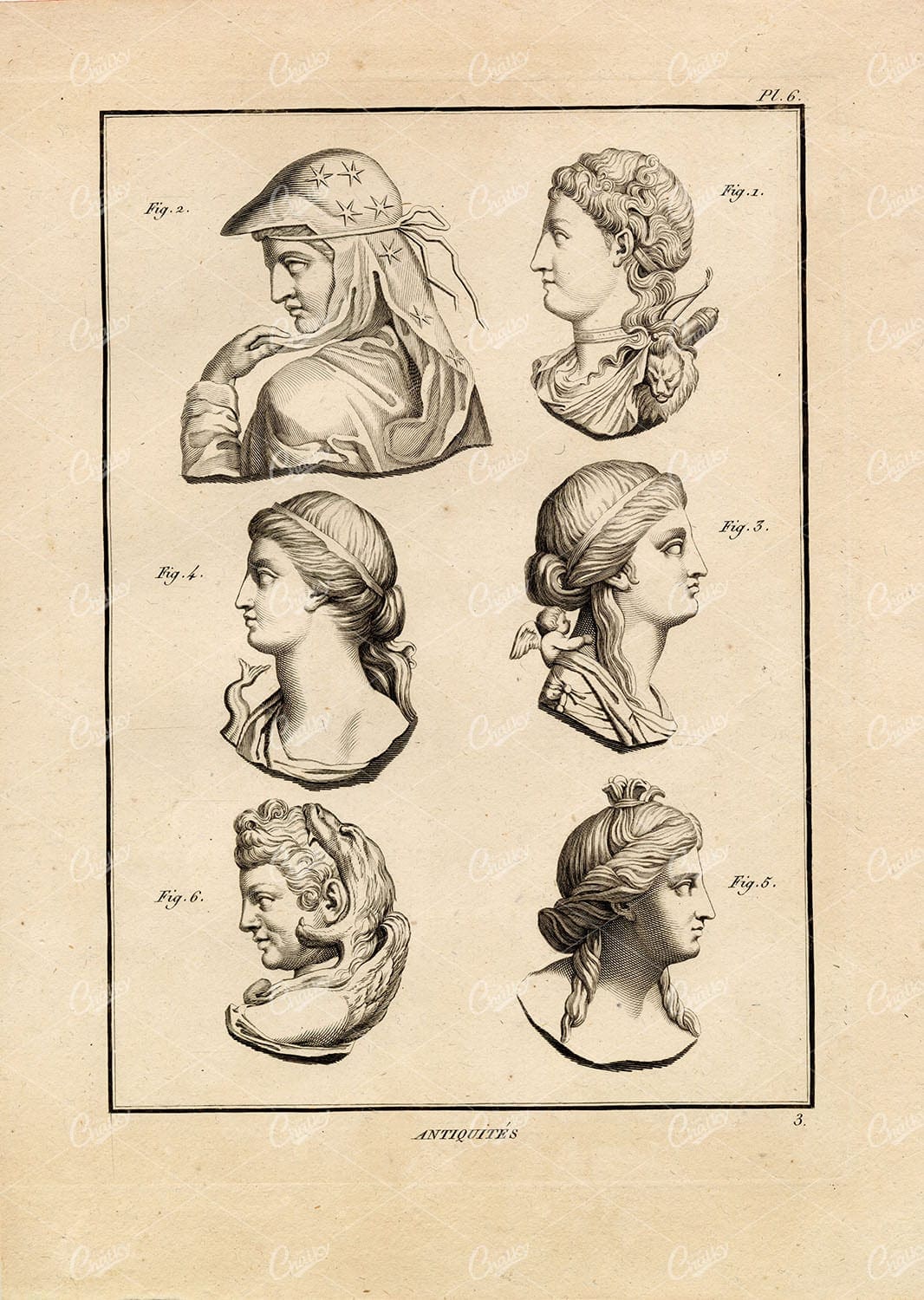
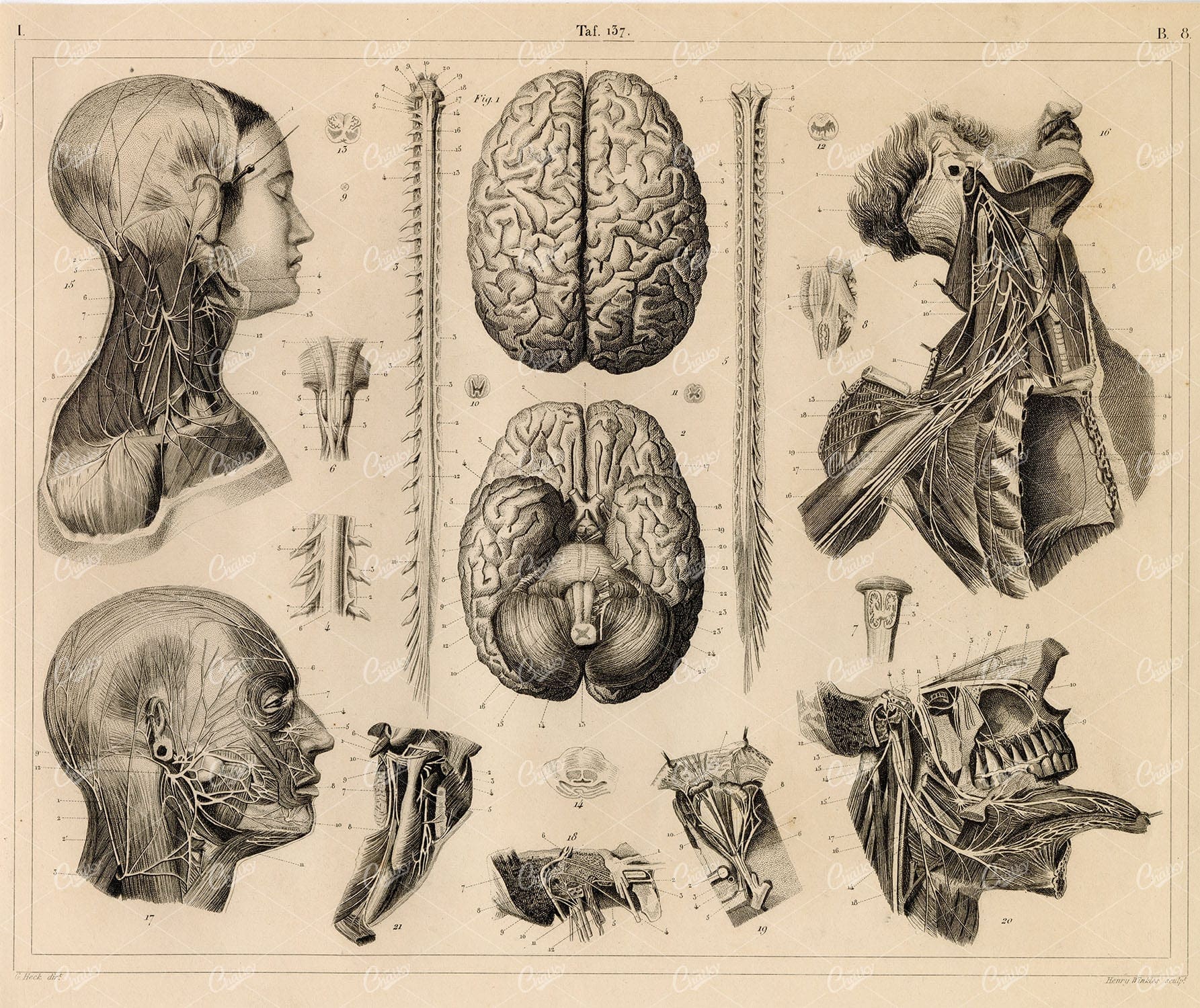

ANTHROPOLOGY – Anatomy of the Brain and Nerves – Johann Heck 1851
You’re looking at a well preserved original plate from Johann Georg Heck's “Iconographic Encyclopedia of Sciences, Literature and Art” published in 1851 by Rudolphe Garrigue in New York. We were extremely fortunate to acquire the full collection of illustrative prints from the series, which after many months of looking, proved to be very difficult!
- License Info
- Resolution: 9374 x 7878 300dpi
- Year of Print: 1851
- Artist: Johann Georg Heck
From this collection
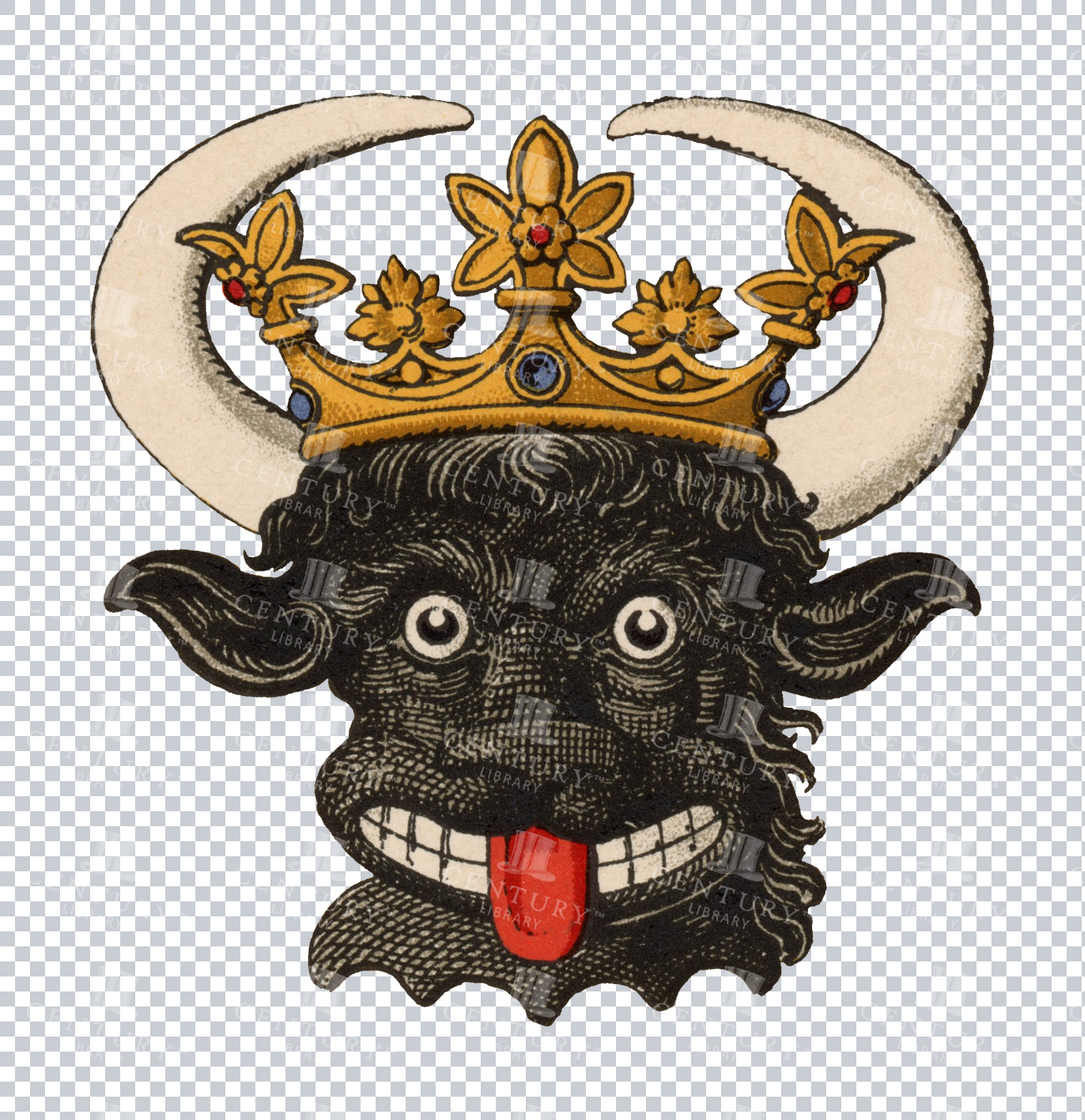

Crowned Bull Head with Horns
A heraldic bull head adorned with a crown and large, curved horns. This symbol of power and royalty is depicted with bold lines and a fierce expression, perfect for medieval-themed designs.
- Resolution: 1769 x 1827
- Image Type(s): PNG
- power
- authority
- traditional art
- crowned
- fierce creature
- bull head
- ornate symbol
- animal head
- fierce
- emblematic
- legendary
- strength
- strong
- medieval art
- powerful
- beast
- bold
- historic
- majestic
- traditional
- detailed
- artistic
- classic
- symbol
- medieval
- Horns
- Regal
- Mask
- Emblem
- Crest
- Art
- Ancient
- Heraldic
- Warrior
- King
- Coat of Arms
- Head
- Animal
- Royalty
- Bull
- Royal
From this collection


Mythical Minotaur Head with Curved Horns, Beaded Adornments, and Fierce Expression
This image is part of our Extensive Collection of 135 Greek, Roman, and Mythology Vintage Line Art Illustrations. Each piece hand-selected from a variety of 19th-century books and ephemera found within our private library.
- Image Type(s): PNG
From this collection


Detailed Skull Illustration of a Horned Dinosaur with Prominent Frill
A detailed illustration of a horned dinosaur skull, featuring a prominent frill and horns. The drawing captures the fossilized structure of this prehistoric animal, emphasizing the unique shape and details of its skull.
- Resolution: 3257px x 2403px
- Image Type(s): PNG
From this collection
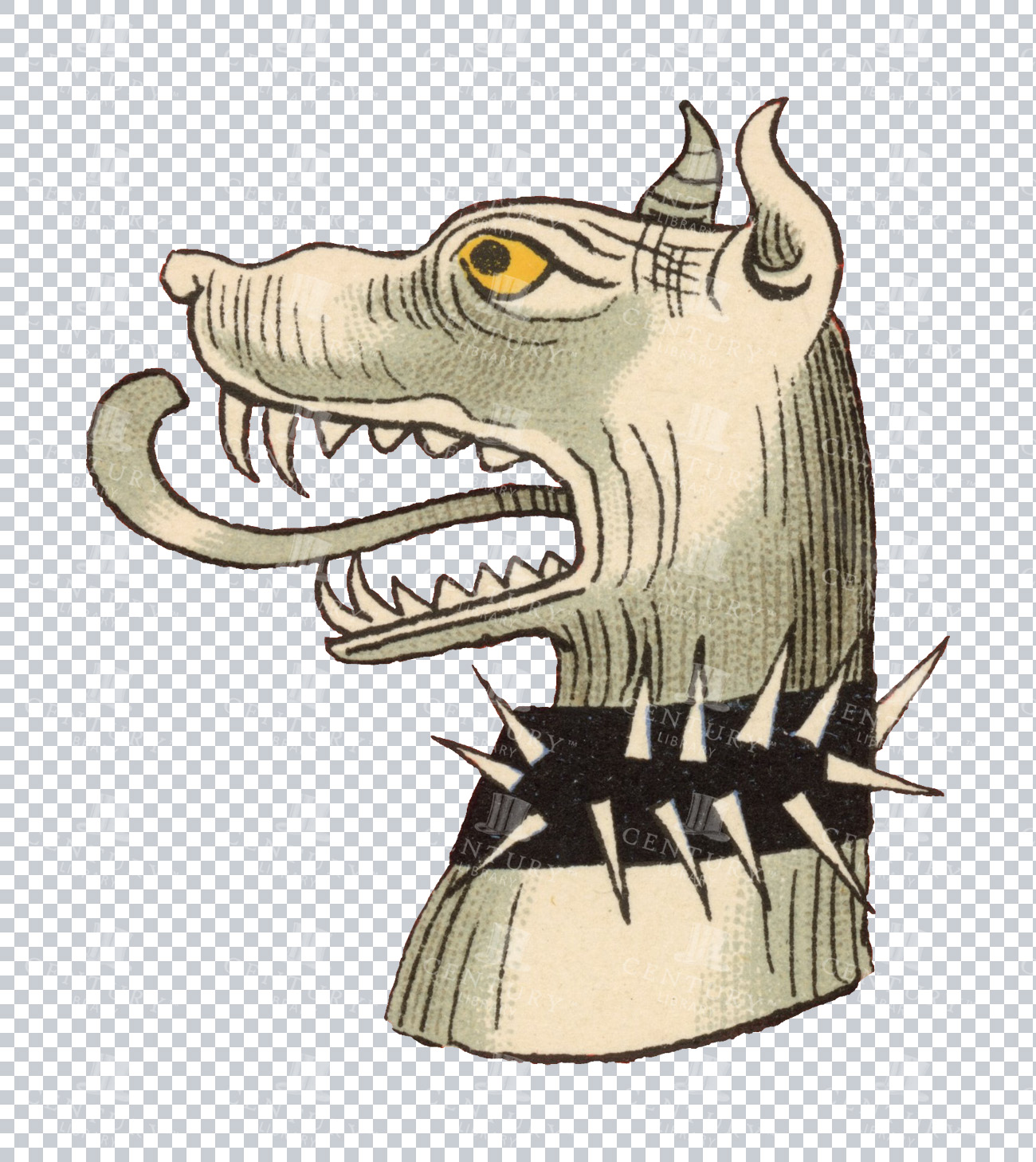

Heraldic Dog Head with Horns and Collar
A stylized heraldic dog head with prominent horns and a spiked collar, showcasing a fierce expression. This unique design reflects medieval artistry and symbolizes strength and protection.
- Resolution: 1409 x 1581
- Image Type(s): PNG
- snarling
- fiercecreature
- collar
- spiked
- protection
- doghead
- protective
- fierce
- emblematic
- legendary
- medievalart
- traditionalart
- strength
- mythological
- powerful
- coatofarms
- beast
- striking
- bold
- historic
- traditional
- detailed
- artistic
- classic
- creature
- symbol
- medieval
- predator
- Horns
- Regal
- Emblem
- Crest
- Art
- Ancient
- Heraldic
- Warrior
- Head
- Canine
- Dog
- Animal
From this collection
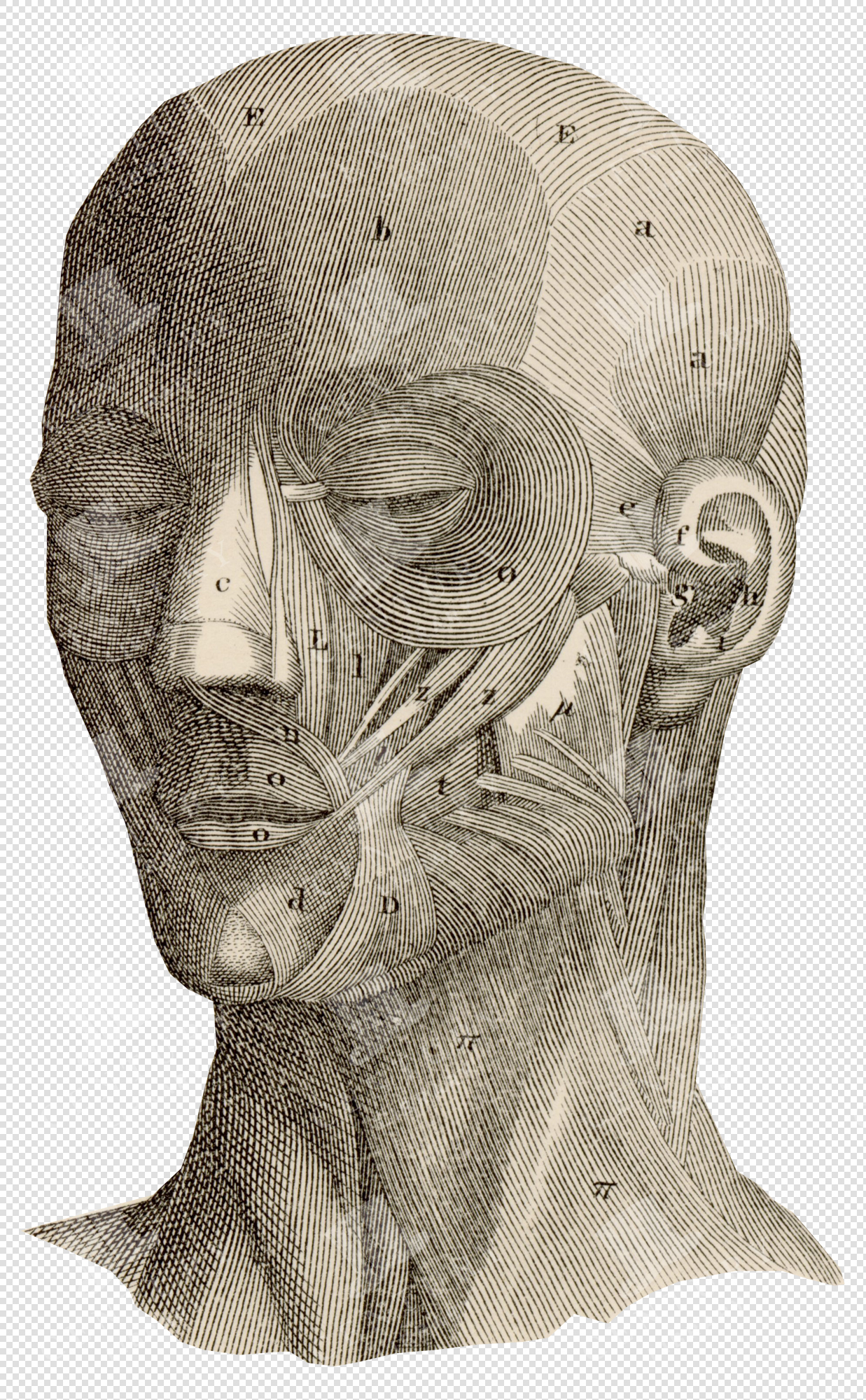

Engraved Anatomical Diagram of Human Facial Muscles
- Image Type(s): PNG
From this collection
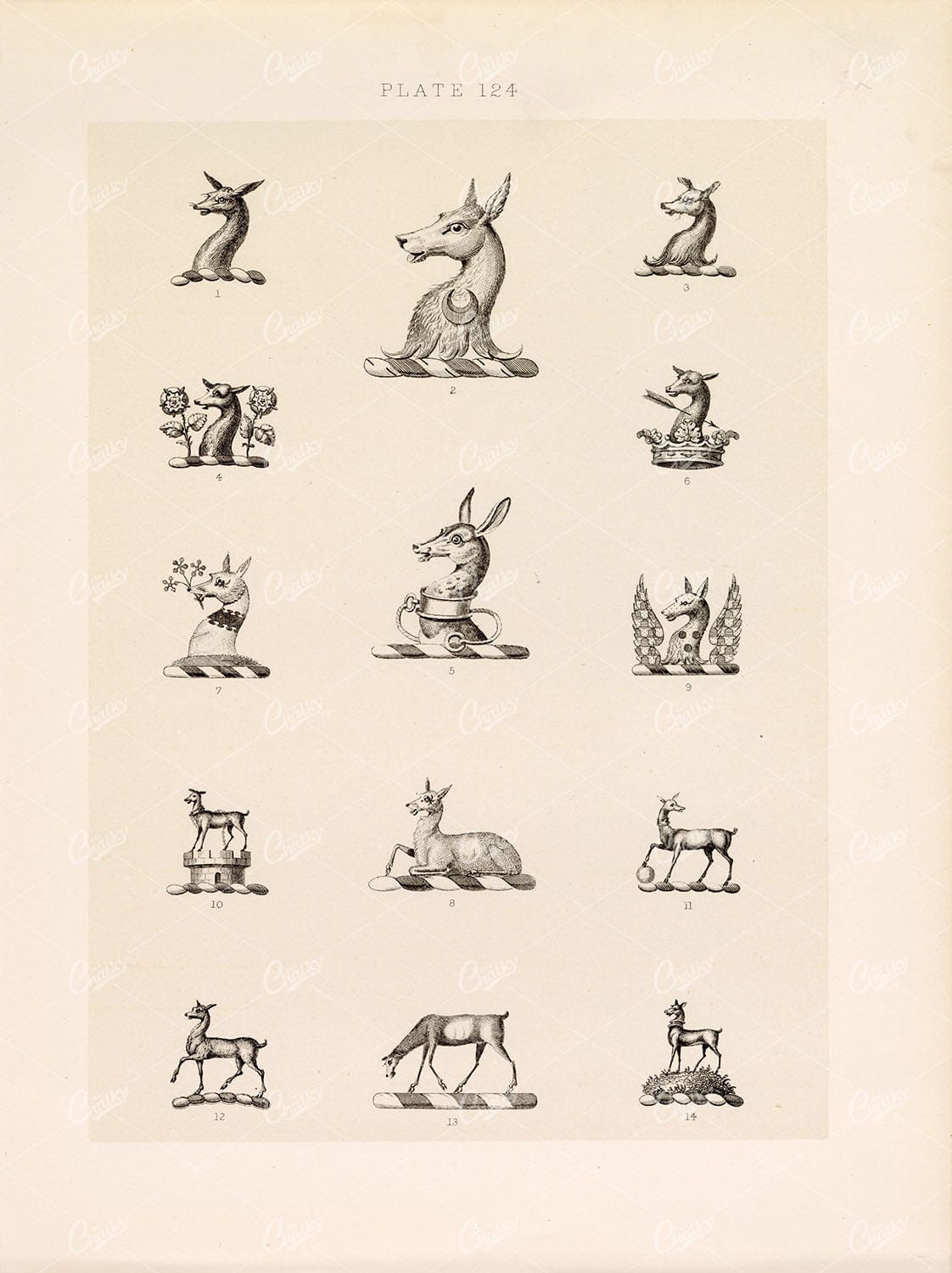

ANTIQUE Original Old Print- Heraldry Crests c1900s Animals Heads
- License Info
- Resolution: 7705 x 10297 300dpi
- Year of Print: 1900
- Artist: Knight & Rumley
From this collection
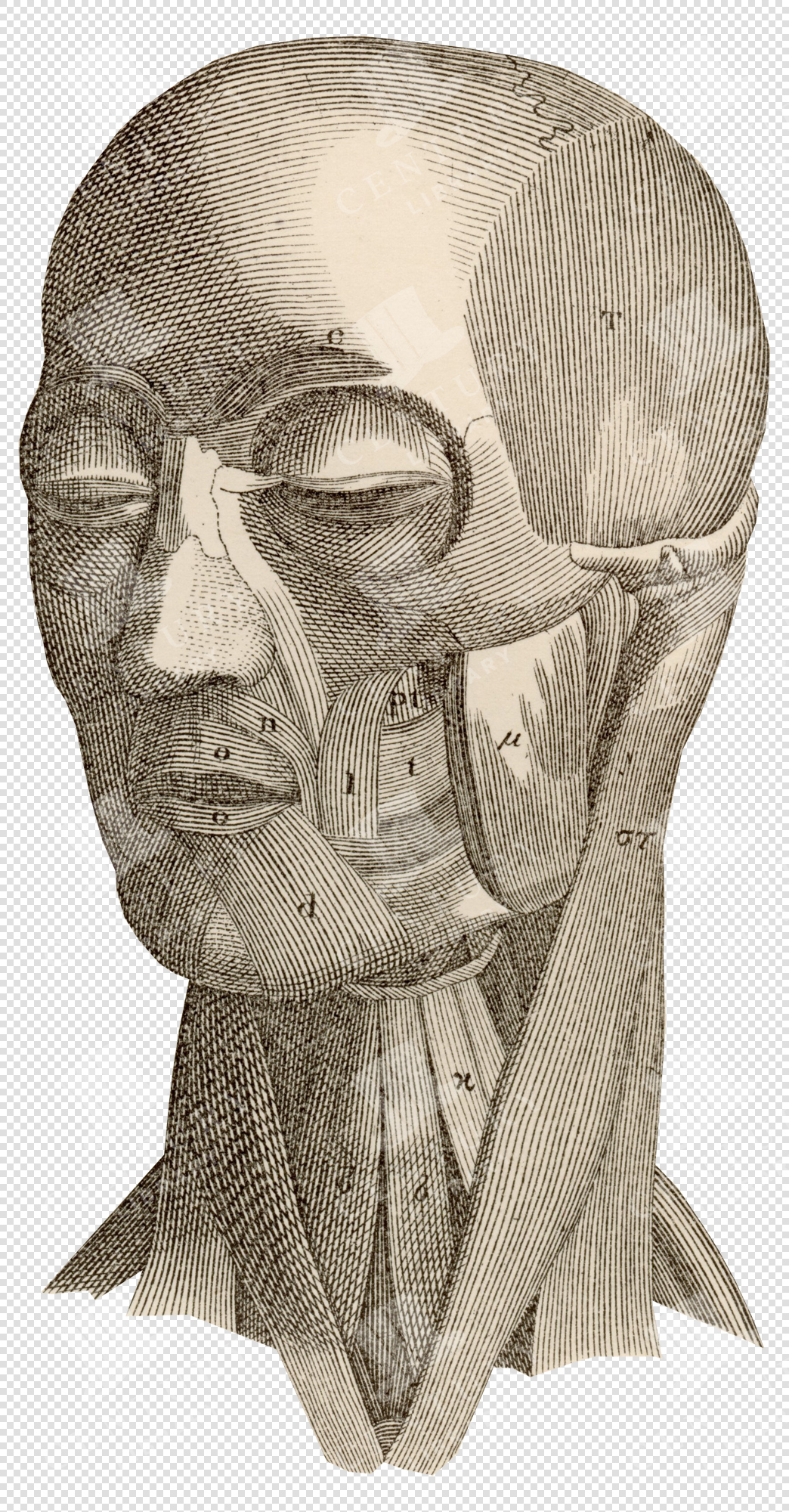

Engraved Anatomical Diagram of Human Facial Muscles and Neck Structure
- Image Type(s): PNG
From this collection
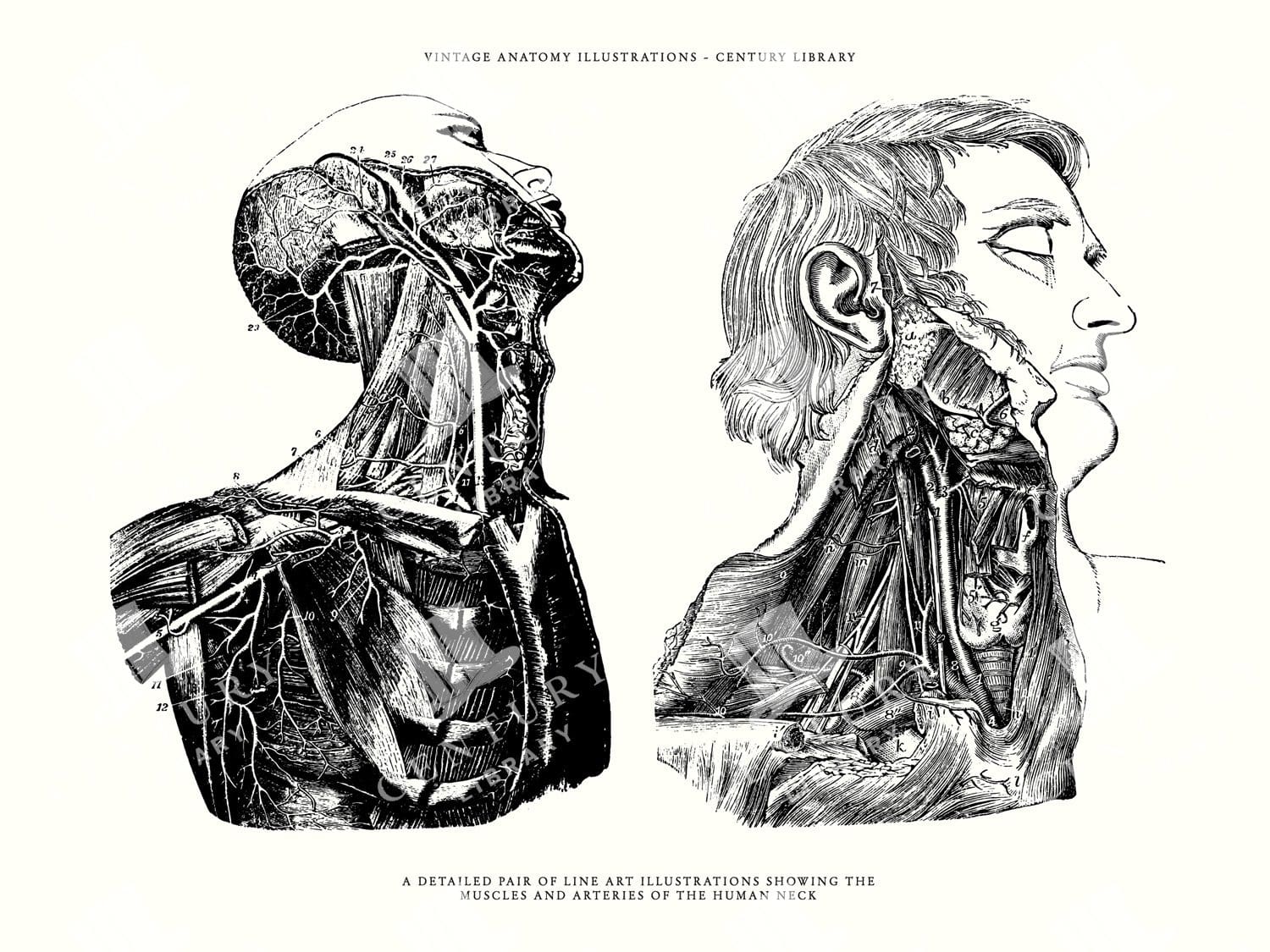

Isolated Human Head Line Art – Anatomy Illustrations in PNG, SVG, and EPS Image Formats
You're looking at a wonderfully restored set of 2 anatomically correct human neck and head illustrations. Each anatomy image was extracted from its original background and converted to the following image formats: SVG (vector), EPS (vector), and, of course, PNG (300dpi raster image with transparent background).
- Image Type(s): EPS, SVG, PNG
Related Images


Mule Deer Head with Large Antlers and Detailed Fur Texture in a Classic Sketch
The head of a Mule deer is depicted with large, branching antlers and detailed fur texture, offering a classic sketch representation of this common North American deer species.
- Resolution: 2747px x 3322px
- Image Type(s): PNG
Related Images
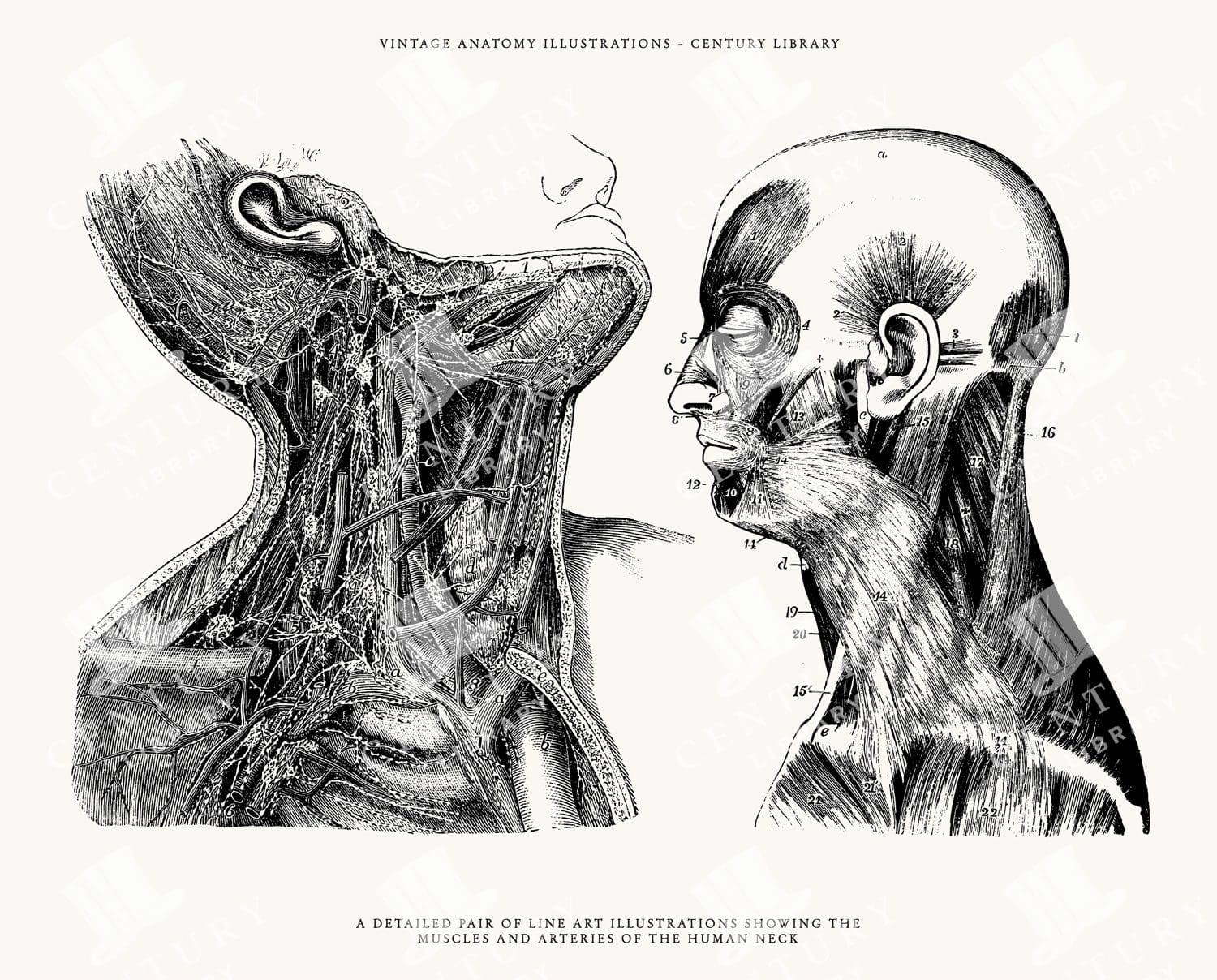

Isolated Human Head Line Art – Anatomy Illustrations in PNG, SVG, and EPS Image Formats
You're looking at a wonderfully restored set of 2 anatomically correct human neck and head illustrations. Each anatomy image was extracted from its original background and converted to the following image formats: SVG (vector), EPS (vector), and, of course, PNG (300dpi raster image with transparent background).
- Image Type(s): EPS, SVG, PNG
From this collection


ANATOMY – Drawing (Contours of the Head) , Antique 1880 Print
An original Antique Plate scan from the National Encyclopaedia: A Dictionary of Universal Knowledge. Published by William Mackenzie in 1880. Click on the Artist's name to see the full collection from this series!
- License Info
- Resolution: 8600 x 5500 300dpi
- Year of Print: 1880
- Artist: William Mackenzie
From this collection


Greek Mythology Ram Head Drawing with Curved Horns and Detailed Wool Texture
This image is part of our Extensive Collection of 135 Greek, Roman, and Mythology Vintage Line Art Illustrations. Each piece hand-selected from a variety of 19th-century books and ephemera found within our private library.
- Image Type(s): PNG
From this collection
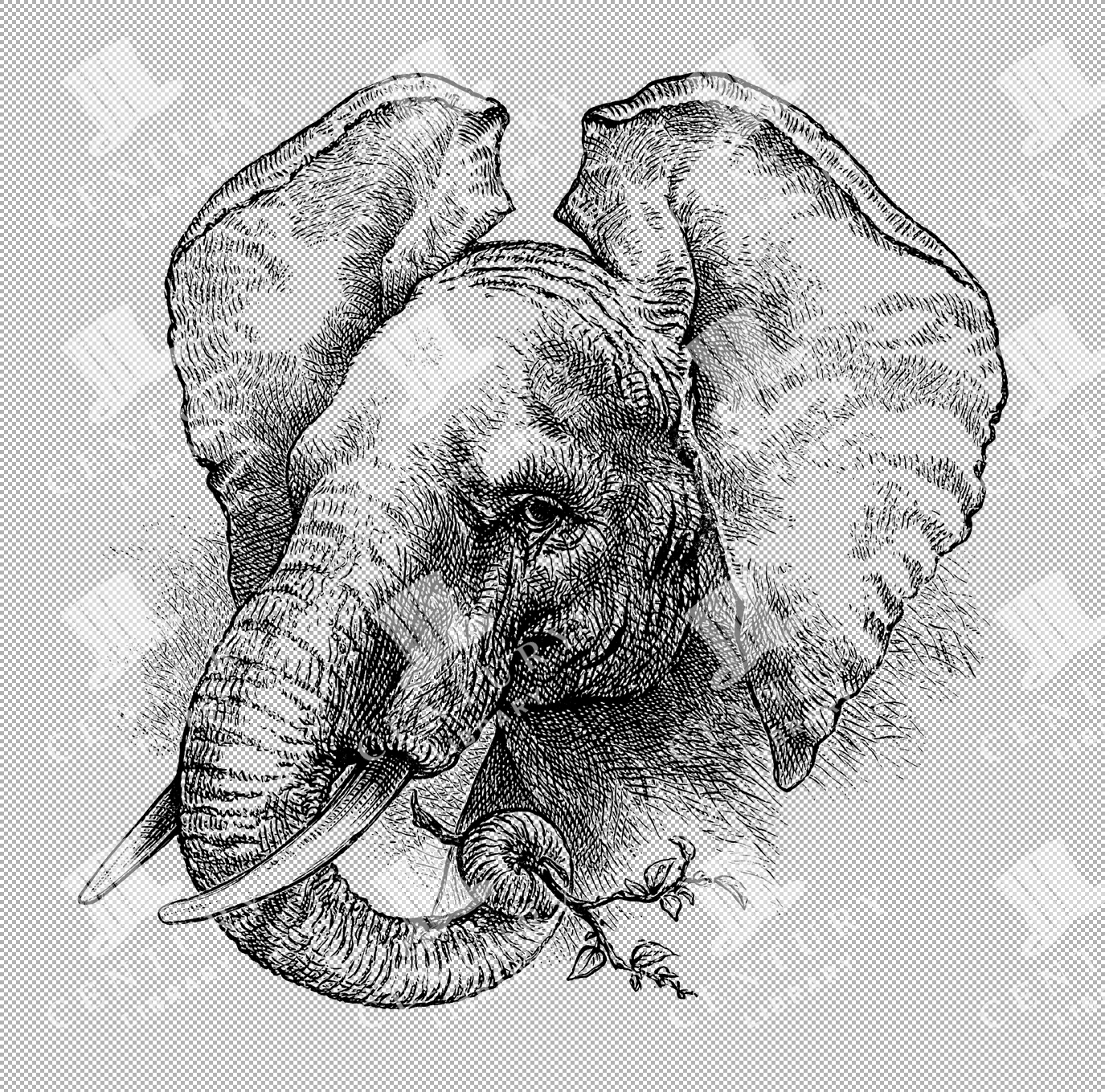

African Elephant Portrait on Transparent PNG
Detailed illustration of an African elephant's head with prominent tusks, set against a transparent background. Perfect for nature and wildlife-themed designs.
- Resolution: 2790px x 2759px
- Image Type(s): PNG
Related Images


ANATOMY – Drawing (Anatomy of Facial Expressions), Antique 1880 Print
An original Antique Plate scan from the National Encyclopaedia: A Dictionary of Universal Knowledge. Published by William Mackenzie in 1880. Click on the Artist's name to see the full collection from this series!
- License Info
- Resolution: 8600 x 5500 300dpi
- Year of Print: 1880
- Artist: William Mackenzie
From this collection
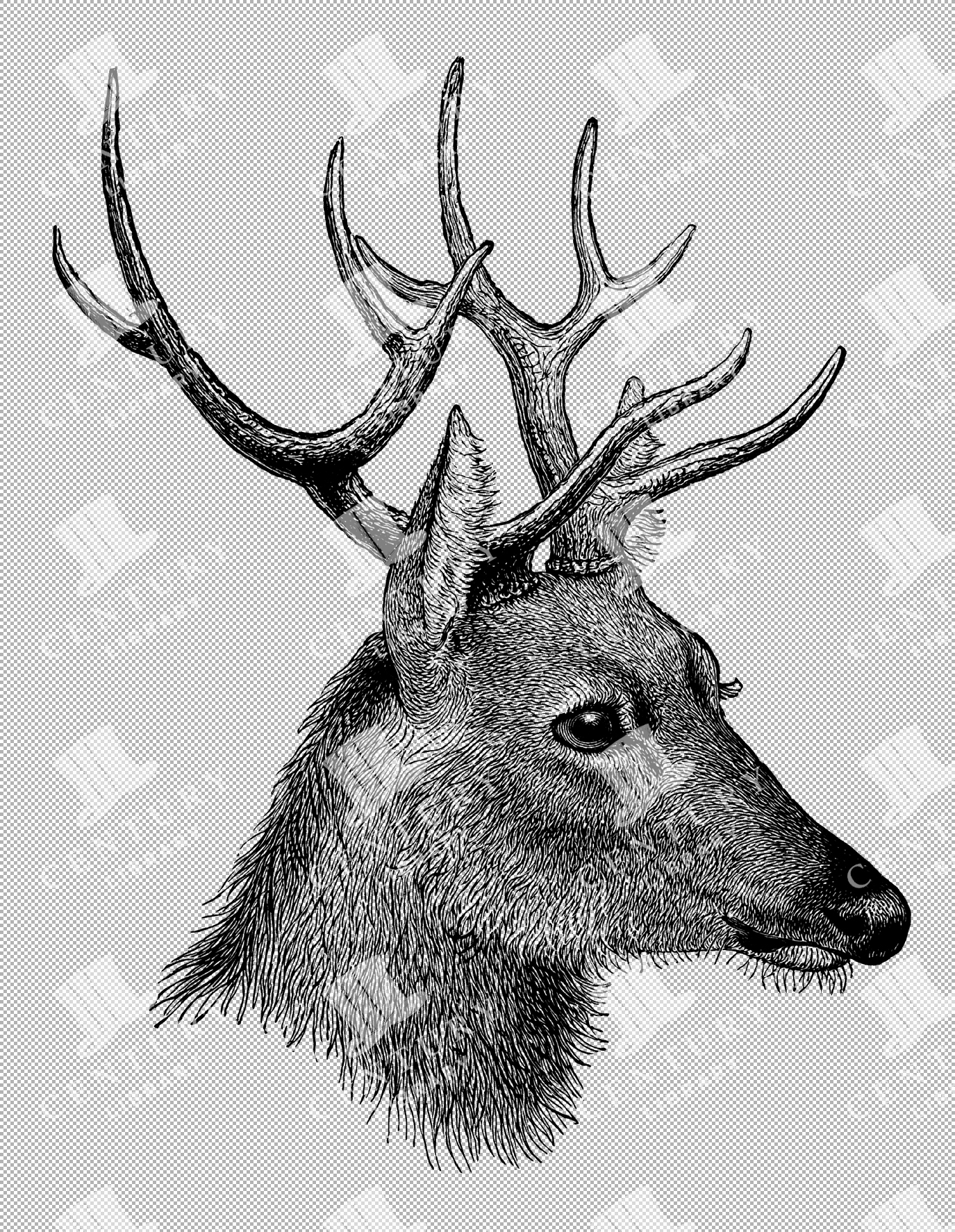

Detailed Illustration of the Head of Schomburgk’s Deer with Prominent Antlers
This image features a detailed illustration of the Schomburgk's deer, highlighting its distinctive head and large, branched antlers. The artwork captures the deer in profile, showcasing its unique antler structure and facial features, set against a neutral background.
- Resolution: 2644px x 3411px
- Image Type(s): PNG
Related Images
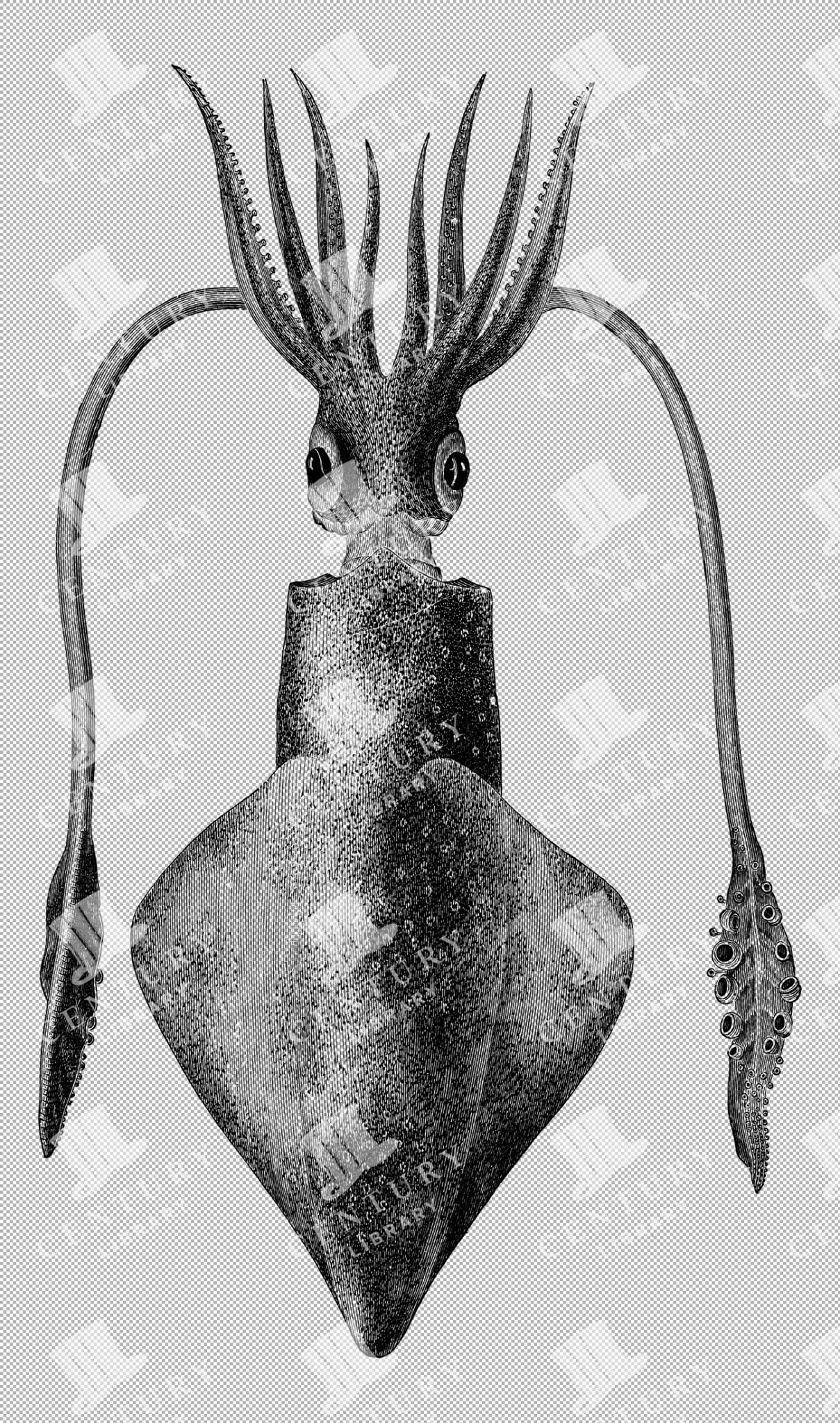

Common Squid with Tentacles and Large Eyes Illustration
This illustration features the common squid, focusing on its streamlined body, large eyes, and long tentacles. The artistic rendering captures the squid's agility and predatory nature in aquatic environments, showcasing its anatomy in an elegant, detailed sketch.
- Resolution: 3599px x 6102px
- Image Type(s): PNG
Related Images


Markhor Head with Twisting Horns and Long Beard in a Highly Detailed Illustration
A highly detailed illustration of the Markhor head, known for its twisting horns and long beard, capturing the distinctiveness of this wild goat species in a classic sketch format.
- Resolution: 2299px x 3929px
- Image Type(s): PNG
Related Images


ORIGINAL Oken’s Naturgeschichte Print – Human Neck, Arm, and Heart Nerves
Original Colour Vintage Print from Lorenz Okenfuss' 'Oken's Naturgeschichte' (Allgemeine Naturgeschichte für alle Stände), with illustrations by Johann Susemihl (1767-1847), and published in Stuttgart by Hoffman between 1839 and 1841. Lorenz Oken (1 August 1779 - 11 August 1851) was a German naturalist, botanist, biologist, and ornithologist. Oken was born Lorenz Okenfuss (German: Okenfuß) in Bohlsbach (now part of Offenburg), Ortenau, Baden, and studied natural history and medicine at the universities of Freiburg and Würzburg. He went on to the University of Göttingen, where he became a Privatdozent (unsalaried lecturer), and shortened his name to Oken. As Lorenz Oken, he published a small work entitled Grundriss der Naturphilosophie, der Theorie der Sinne, mit der darauf gegründeten Classification der Thiere (1802). This was the first of a series of works which established him as a leader of the movement of "Naturphilosophie" in Germany.
- License Info
- Resolution: 9500 x 11500 300dpi
- Year of Print: 1836
- Artist: Lorenz Oken
- Image Type(s): JPG
From this collection


Occult Style Vintage Illustration of a Human with Bull Head Isolated PNG
A vintage line art illustration of a human with a bull head, isolated in PNG format, ideal for occult, mystical, and alchemical-themed designs.
- Image Type(s): PNG
Related Images
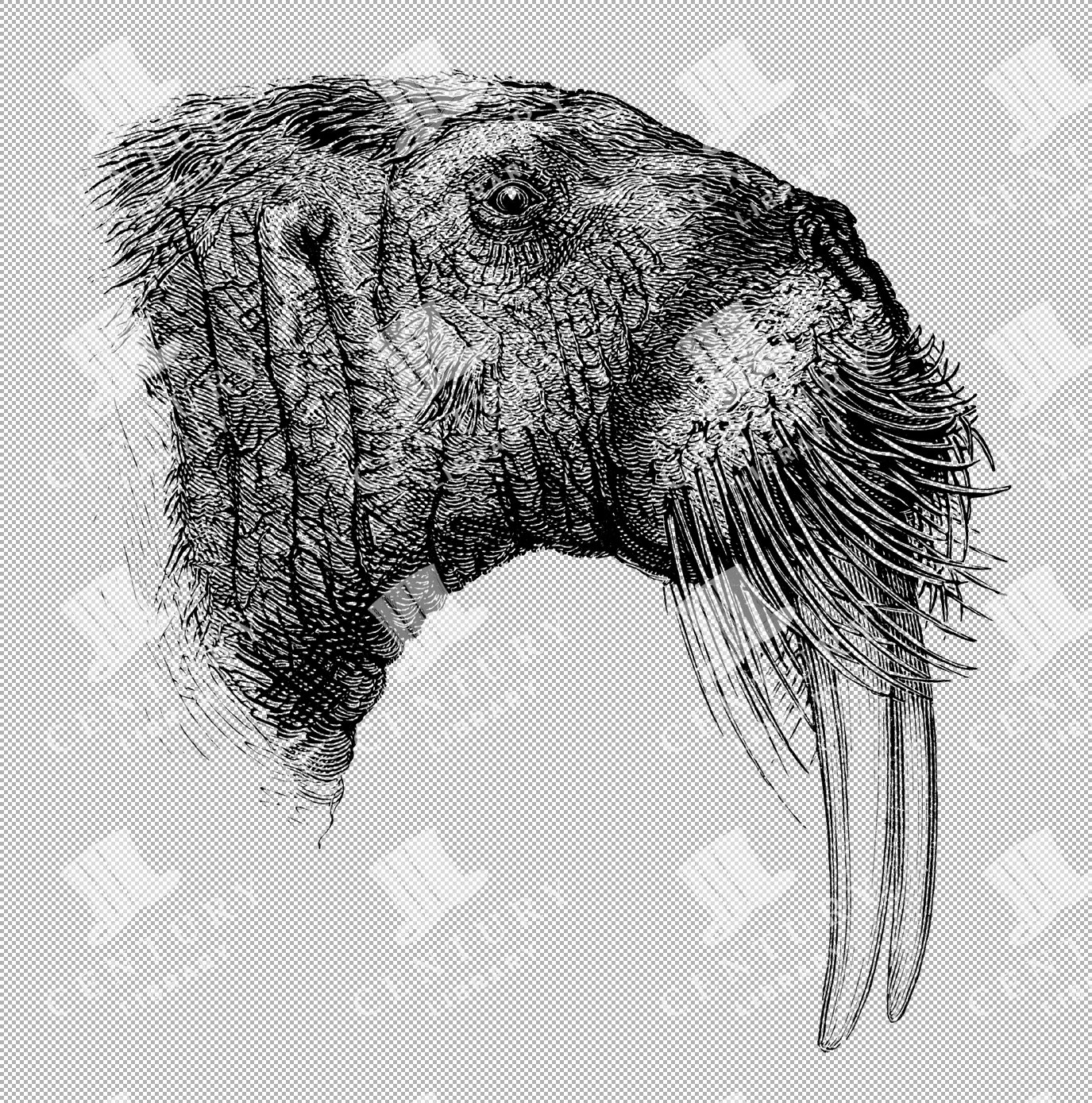

Detailed Drawing of Walrus Head with Prominent Tusks and Whiskers
A detailed depiction of a walrus head, showcasing its large tusks and thick whiskers. This engraved illustration captures the walrus's distinct facial features in a realistic style, highlighting its robust structure and marine adaptation.
- Resolution: 2655px x 2683px
- Image Type(s): PNG
Related Images
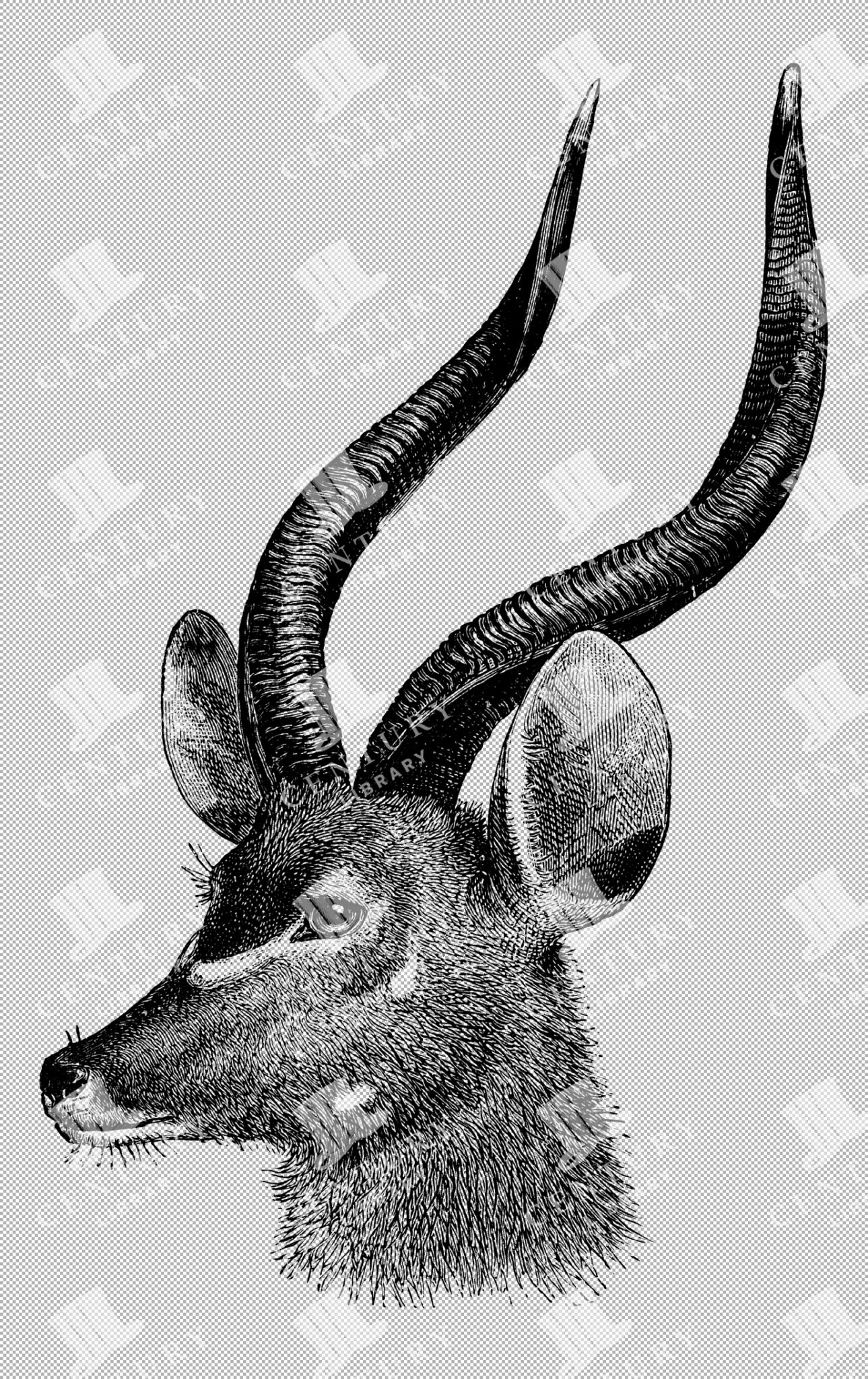

West African Harnessed Antelope Bust Isolated Line Art in PNG
Illustration of a West African harnessed antelope bust, isolated in PNG format, capturing the detailed horn structure and facial features
- Resolution: 2576px x 4094px
- Image Type(s): PNG
Related Images
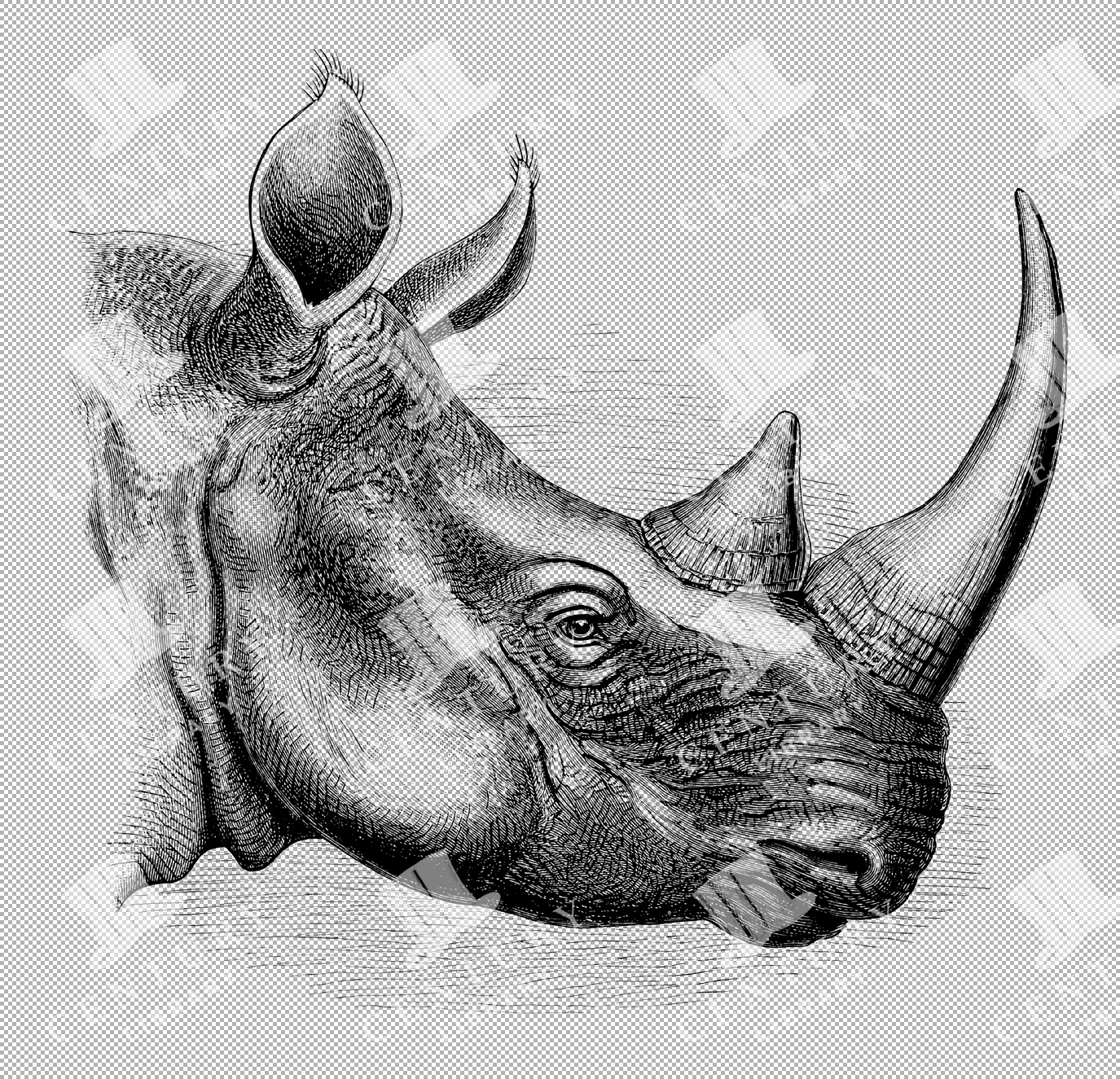

Illustration of Burchell’s Rhino Head with Distinctive Two Horns and Detailed Skin Texture
A vintage illustration of the head of Burchell's rhino showcasing its two prominent horns and rough skin texture, highlighting the unique features of this species in a detailed sketch.
- Resolution: 3863px x 3723px
- Image Type(s): PNG
Related Images


Fringe-Eared Oryx Illustration on Transparent Background
Illustration of a fringe-eared oryx head, featuring long straight horns and distinct facial markings, isolated on a transparent background.
- Resolution: 1959px x 2653px
- Image Type(s): PNG
- adornment
- Africa
- African
- Animal
- Antelope
- Antelopes
- Art
- Black and white
- Bovidae
- Decoration
- Decorative
- detailed
- distinctive
- Drawing
- elegant
- endangered
- Facial Markings
- Fringe-Eared
- Grazers
- Grazing
- Head
- Horns
- illustration
- isolated
- Isolated Image
- Long Horns
- Mammal
- Natural History
- Nature
- Ornate
- Oryx
- pendant
- PNG
- savanna
- sketch
- species
- Species Identification
- symmetry
- transparent background
- Wildlife
- Wildlife Art
- Wildlife Illustration
- Zoology
Related Images
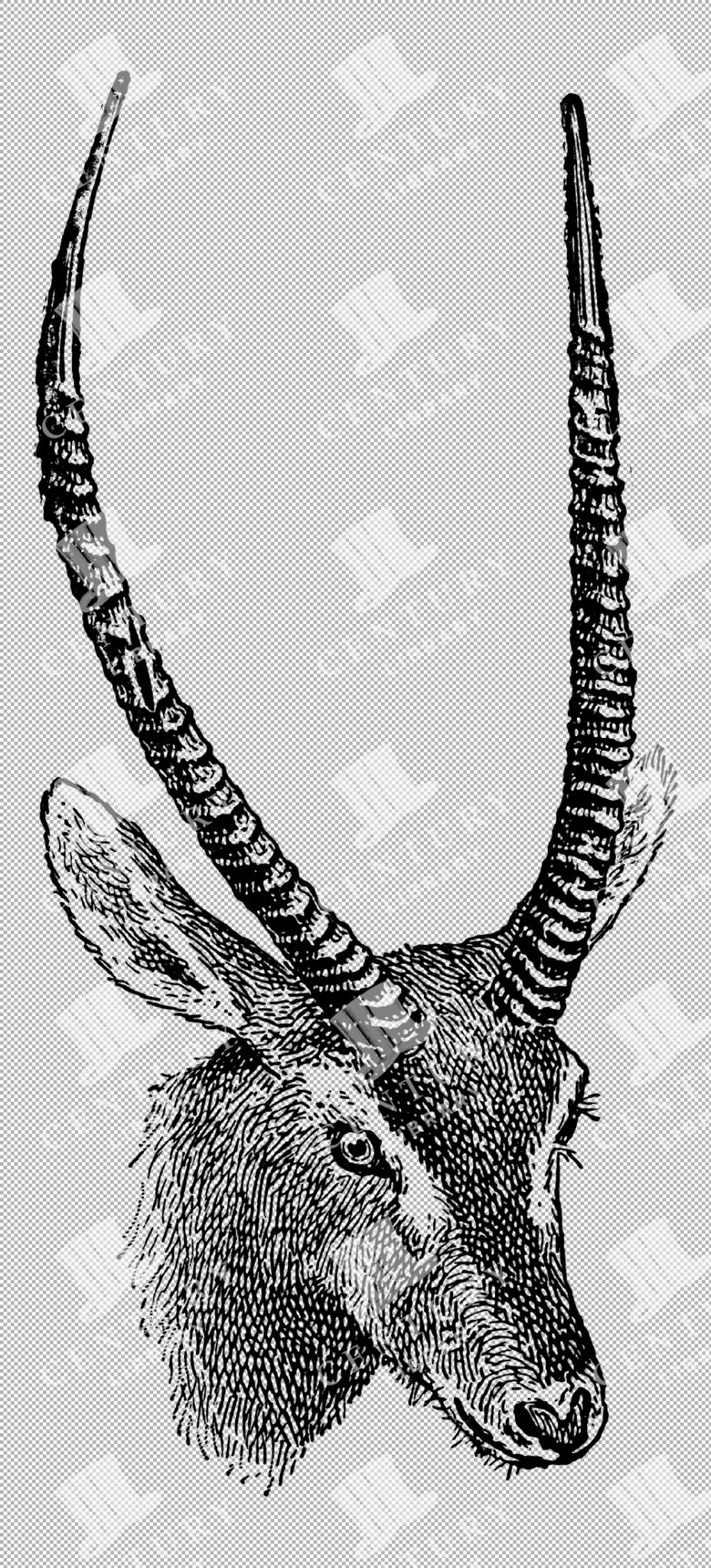

Illustration of Water-Buck Head with Prominent Ringed Horns and Ears
This image illustrates the head of a water-buck, focusing on its prominent ringed horns and large ears. The drawing captures the unique features of this antelope, showcasing its adaptations to wetland environments in a classic engraved style.
- Resolution: 1298px x 2861px
- Image Type(s): PNG
Related Images
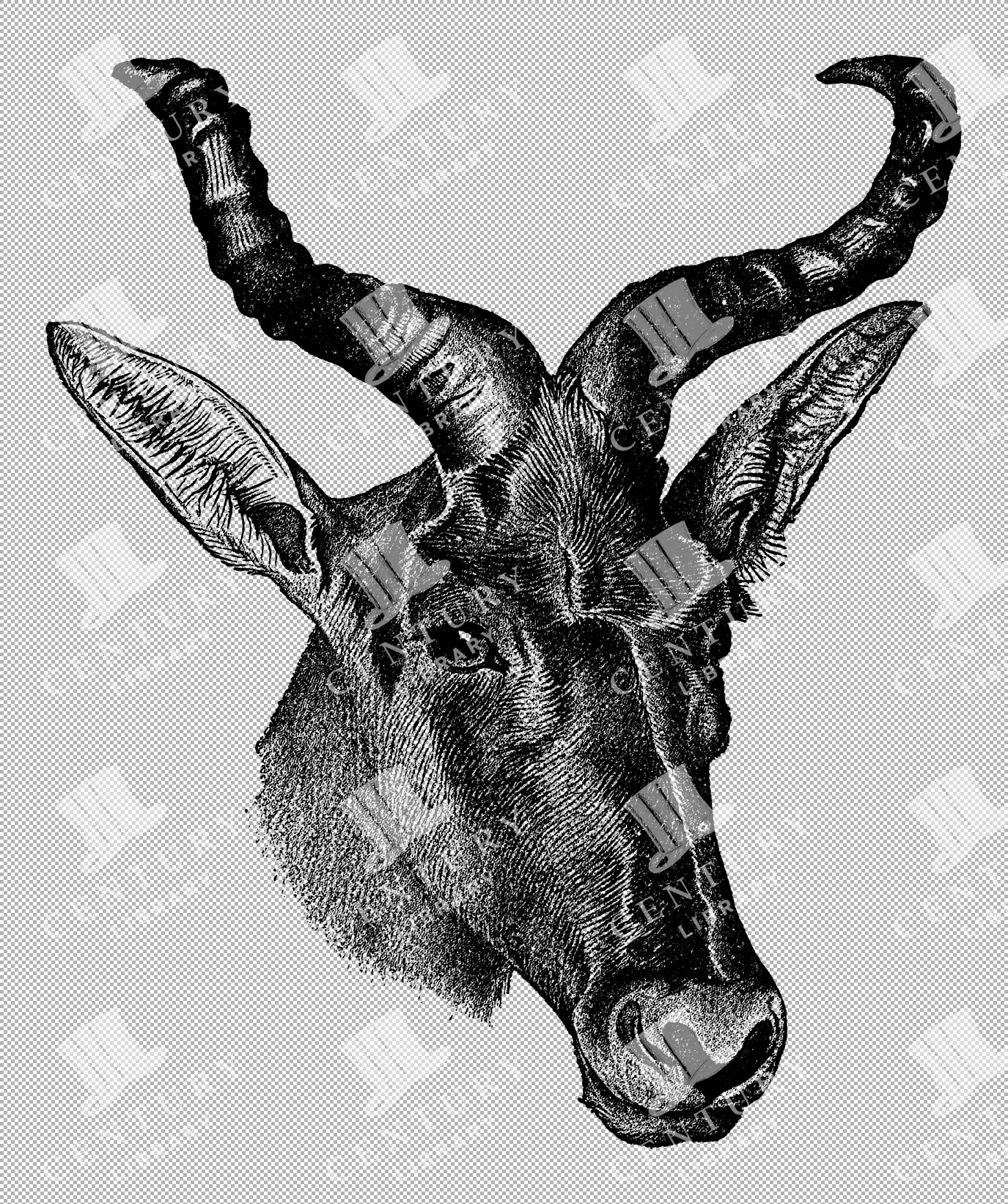

Profile Drawing of Swayne’s Hartebeest Head with Characteristic Curved Horns
A detailed illustration depicting the head of Swayne's hartebeest, focusing on its distinct curved horns and elongated face. The artwork captures the animal’s unique features in a classic, engraved style, ideal for educational and reference purposes.
- Resolution: 2653px x 3169px
- Image Type(s): PNG
Related Images
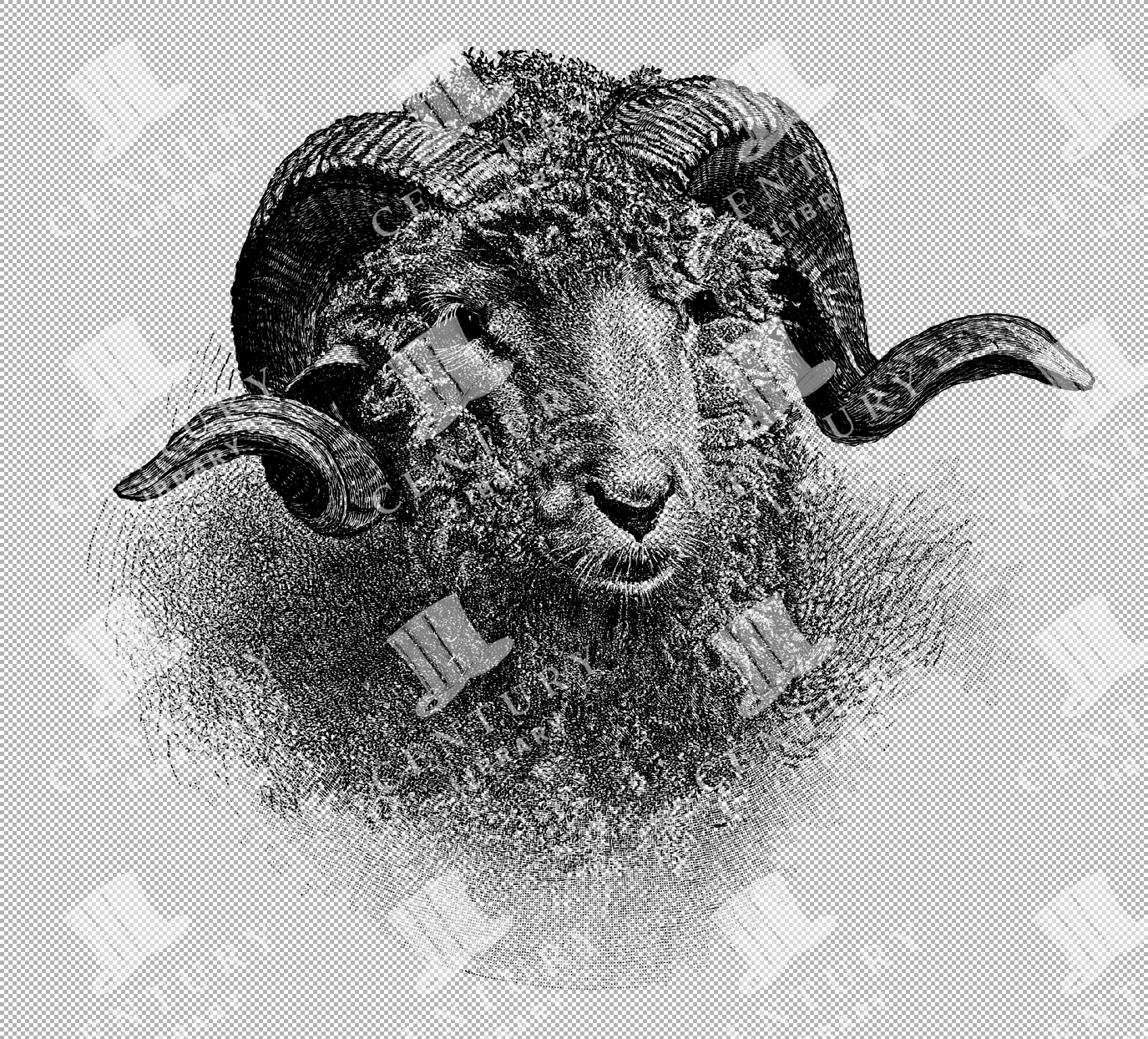

Illustration of Marino Ram Head with Curling Horns and Detailed Fleece Texture
This illustration of a Marino ram head features curling horns and a detailed fleece texture, showcasing the characteristic features of this woolly sheep breed in a vintage style.
- Resolution: 3516px x 3182px
- Image Type(s): PNG
Related Images
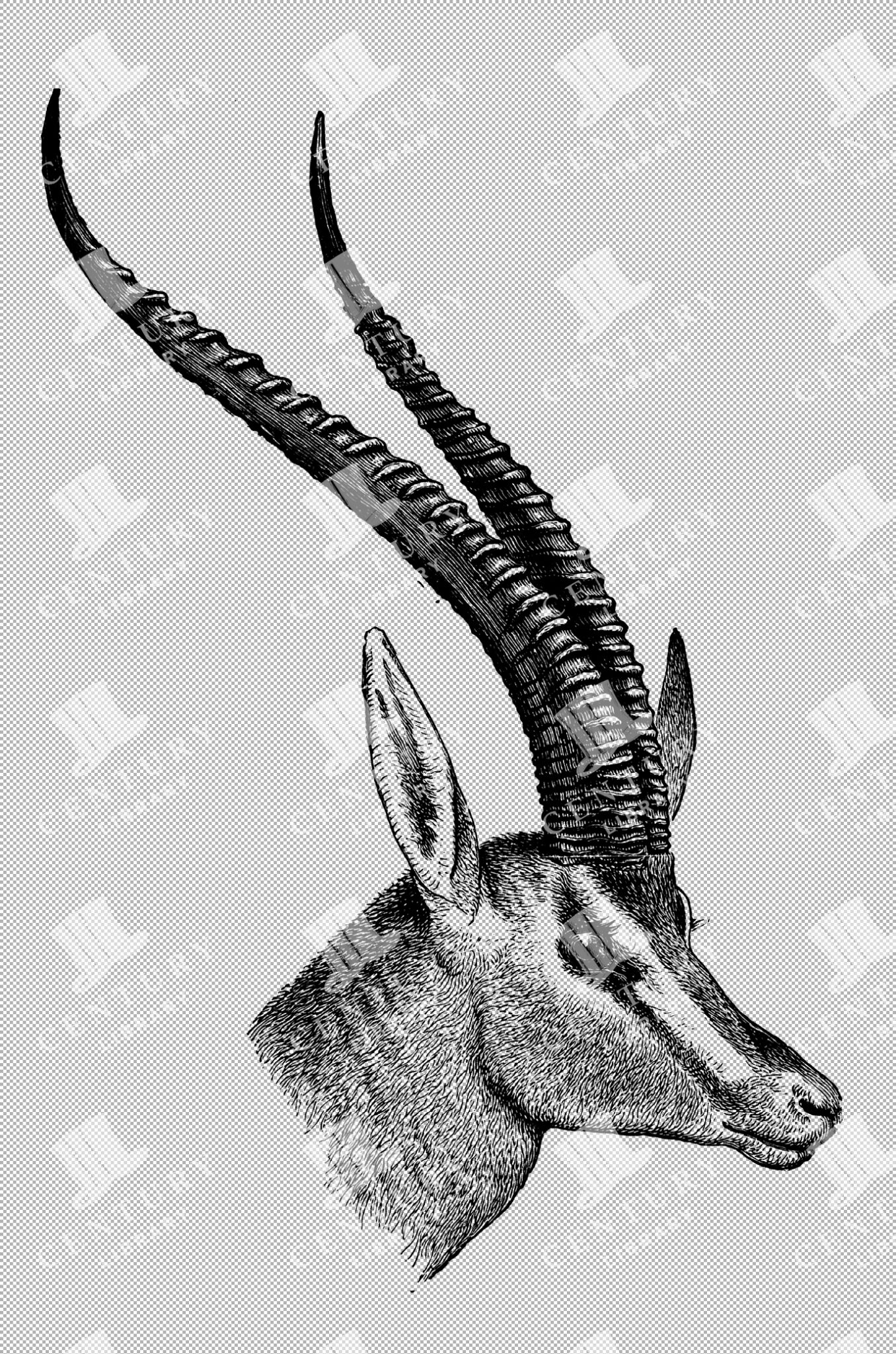

Grant’s Gazelle Head Profile with Elegant Curved Horns and Detailed Facial Expression
A vintage sketch showing Grant's gazelle head profile with elegantly curved horns and detailed facial features, capturing the grace and distinctive traits of this African antelope species.
- Resolution: 2641px x 3990px
- Image Type(s): PNG
Related Images


Cyprian Sheep Head with Spiral Horns and Dense Woolly Texture in Vintage Illustration
The head of a Cyprian sheep is illustrated with its characteristic spiral horns and dense woolly texture, providing a detailed look at this unique sheep breed in a classic artwork style.
- Resolution: 2852px x 2164px
- Image Type(s): PNG
Related Images
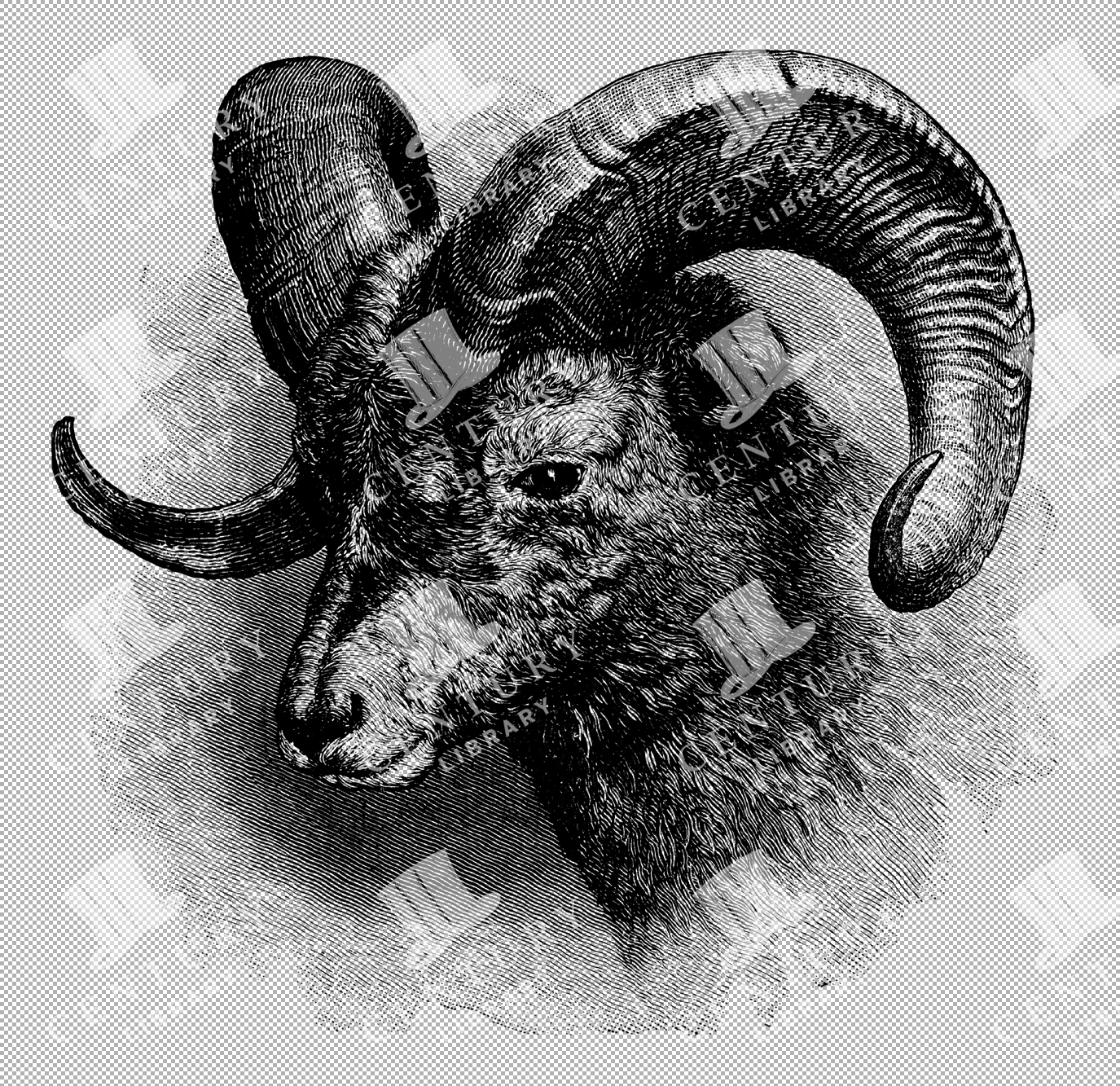

Illustration of Wild Sheep Head with Curling Horns and Textured Wool
A detailed engraving of a wild sheep’s head, highlighting its curling horns and textured wool. The artwork captures the rugged appearance of the sheep, emphasizing its distinctive facial features and woolly coat.
- Resolution: 2826px x 2740px
- Image Type(s): PNG
Related Images


Side View of Chiru Antelope Head with Long, Slender Horns and Detailed Facial Features
This side view illustration of a Chiru antelope highlights its long, slender horns and distinct facial features, capturing the elegance and uniqueness of this high-altitude dwelling species.
- Resolution: 2230px x 4511px
- Image Type(s): PNG
Related Images


Engraved Illustration of the Head of the Senegal Antelope with Slender Horns
This detailed engraving portrays the head of a Senegal antelope, emphasizing its slender horns and alert expression. The artwork captures the elegance and distinctive characteristics of the antelope, making it a great visual for wildlife studies.
- Resolution: 2195px x 3916px
- Image Type(s): PNG
Related Images


Hunter’s Hartebeest Head with Distinctive Long Horns and Detailed Fur Texture in Sketch
Illustration of Hunter's Hartebeest head with its distinctive long, straight horns and detailed fur texture, presented in a classic sketch style to highlight its unique features.
- Resolution: 2083px x 4849px
- Image Type(s): PNG
Related Images
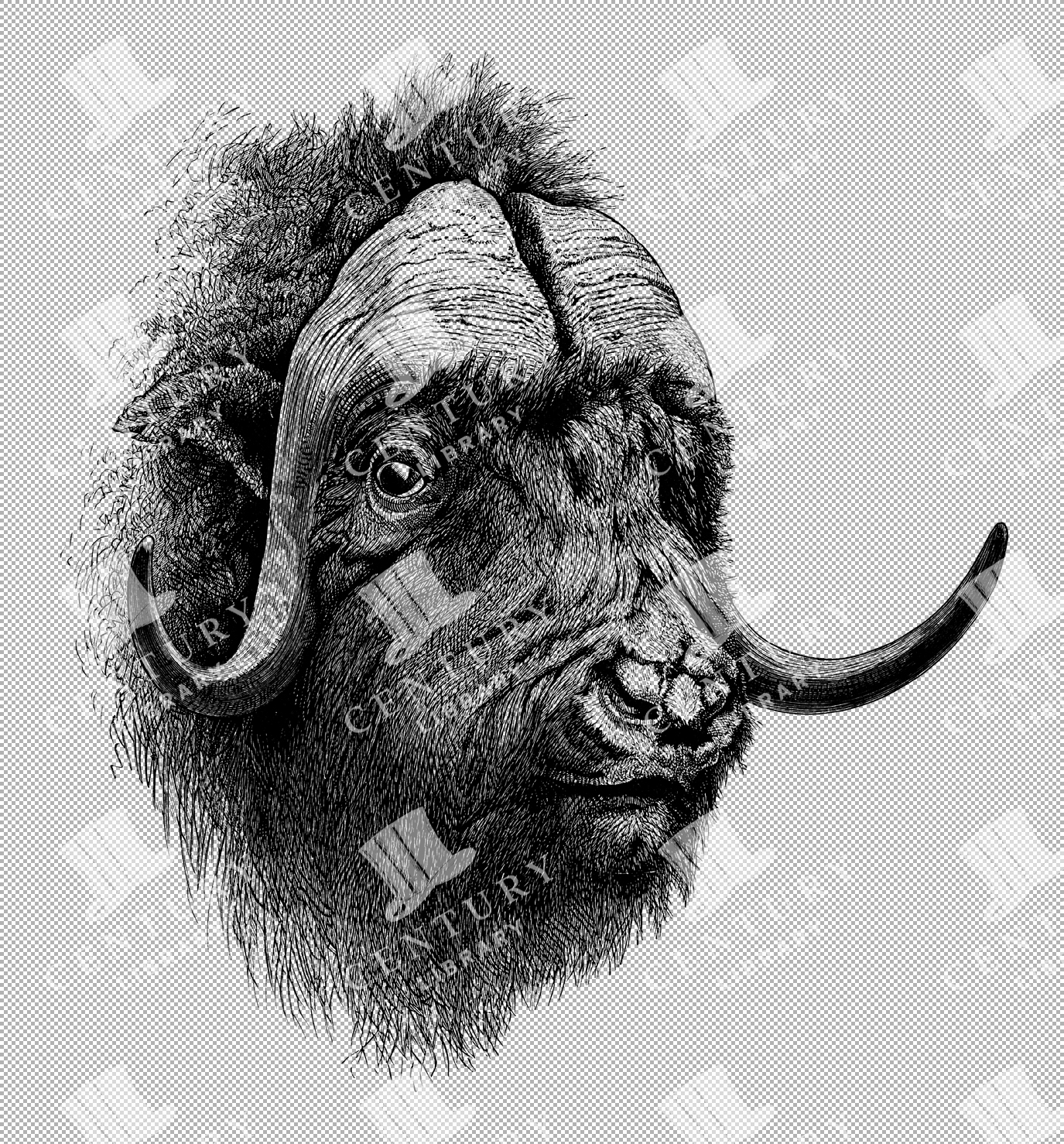

Musk-Ox Head Illustration Highlighting Massive Horns and Dense Fur
A vintage illustration of a musk-ox head, focusing on its massive horns and dense fur. This detailed artwork captures the rugged and distinctive features of this powerful animal in a classic etching style.
- Resolution: 4487px x 4826px
- Image Type(s): PNG
Related Images


Detailed Illustration of a Brown Bear Head Emphasizing Fur Texture
A close-up vintage illustration of a brown bear's head, emphasizing the detailed fur texture and facial features. This artwork captures the bear's intense gaze and characteristic look in a classic etching style.
- Resolution: 3257px x 2613px
- Image Type(s): PNG
Related Images
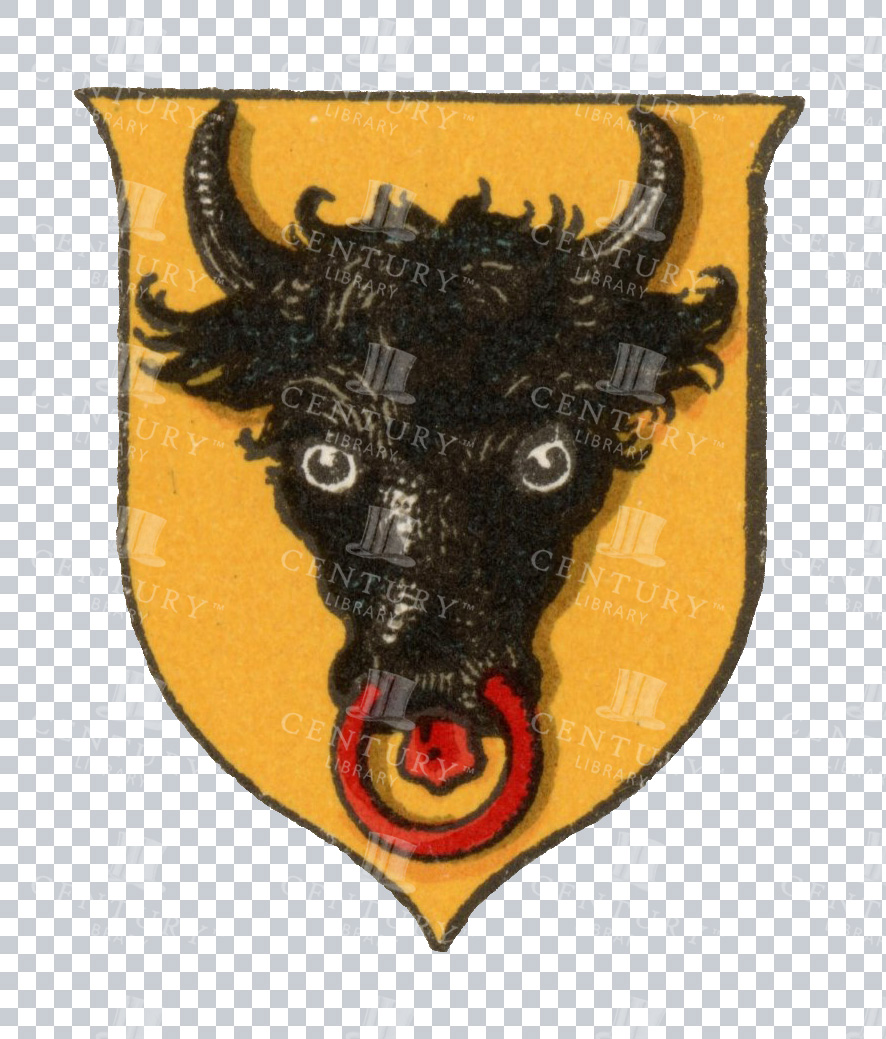

Bull’s Head Heraldic Emblem Vintage Illustration
An isolated PNG image of a bull's head, rendered in a vintage heraldic style. The bull is a symbol of strength, determination, and leadership in many heraldic traditions. This bold design element is ideal for use in projects that need a strong and authoritative emblem.
- Resolution: 738 x 866
- Image Type(s): PNG
- Animal
- Antique
- Armor
- Art
- Artwork
- Bull
- classic
- coatofarms
- covering
- Crest
- culture
- Decorative
- Design
- determination
- Emblem
- Graphic
- Head
- Heraldry
- historical
- History
- iconography
- identity
- illustration
- isolated
- leadership
- legacy
- medieval
- nobility
- noble
- PNG
- protective covering
- Royalty
- Shield
- strength
- strong
- style
- symbol
- tradition
- traditional
- vintage
Related Images
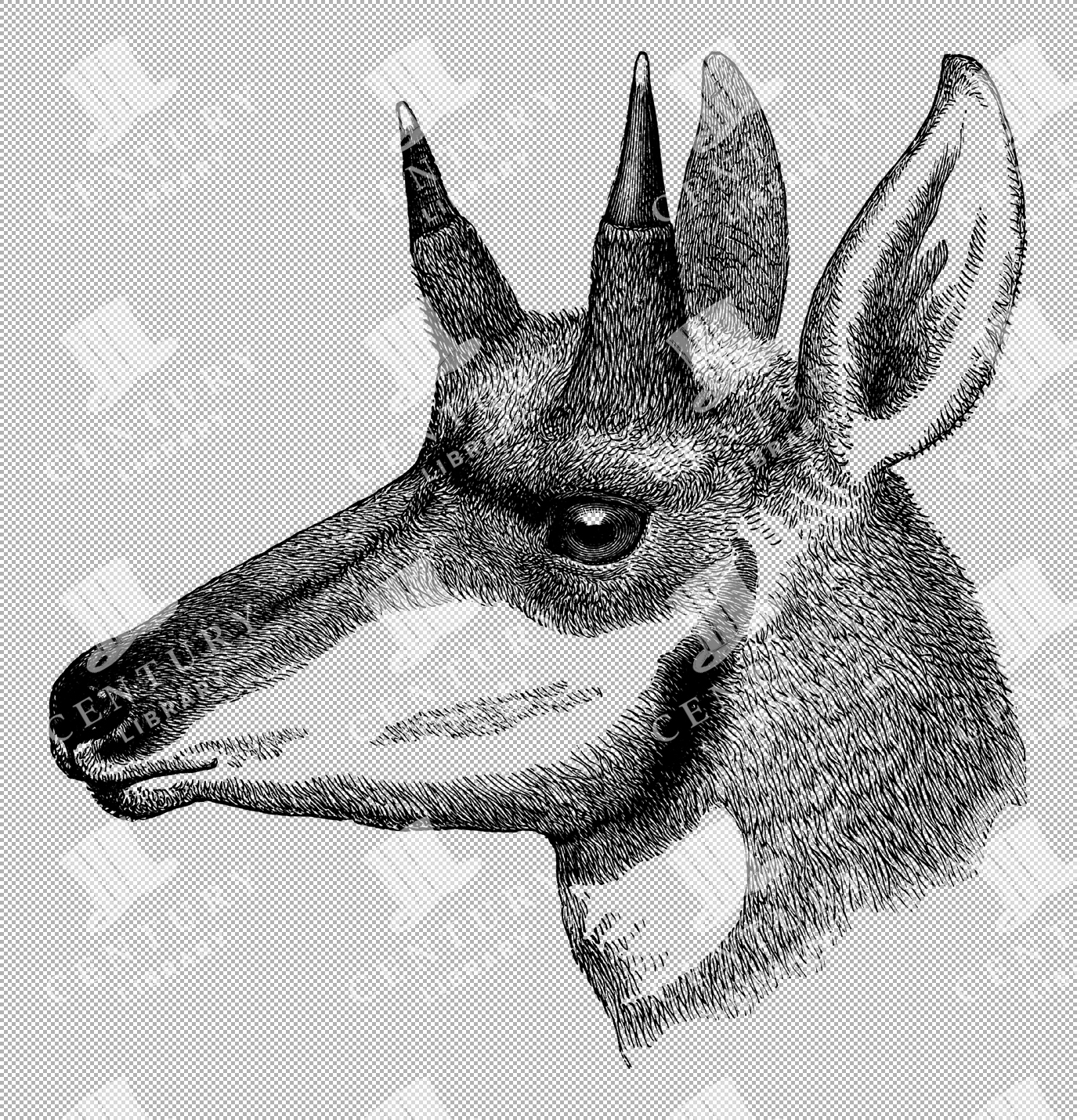

Prongbuck Head with Small Horns and Detailed Fur Texture in a Vintage Illustration
A vintage illustration of a Prongbuck head, featuring small horns and a detailed fur texture, highlighting the unique features of this North American species in a classic artwork style.
- Resolution: 3203px x 3330px
- Image Type(s): PNG
Related Images
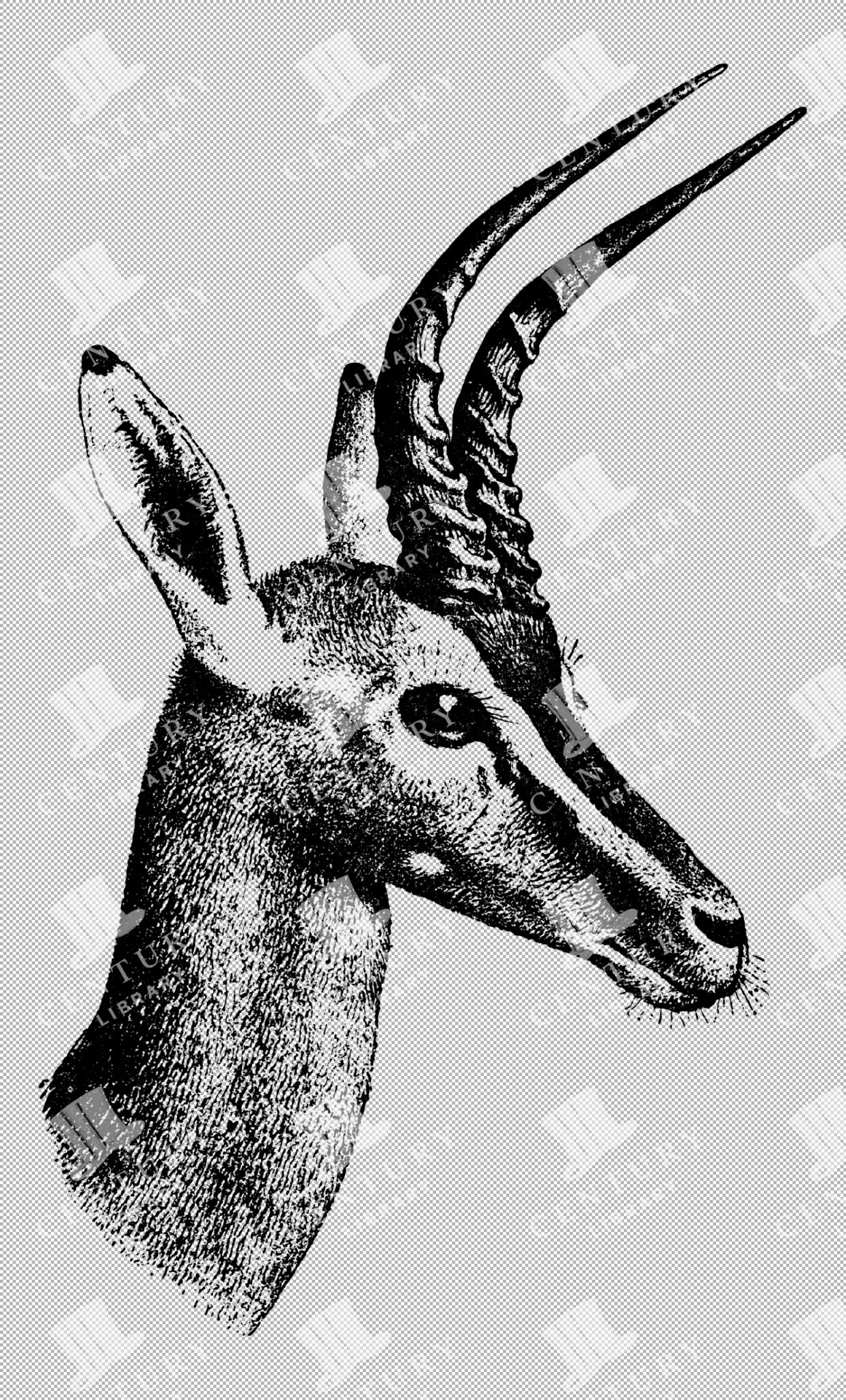

Head of Clarke’s Antelope with Long Curved Horns and Furry Coat in Detailed Illustration
A detailed sketch of Clarke's antelope head, featuring its long, curved horns and furry coat, exemplifying the animal's distinctive characteristics in a vintage style illustration.
- Resolution: 1802px x 2983px
- Image Type(s): PNG
Related Images
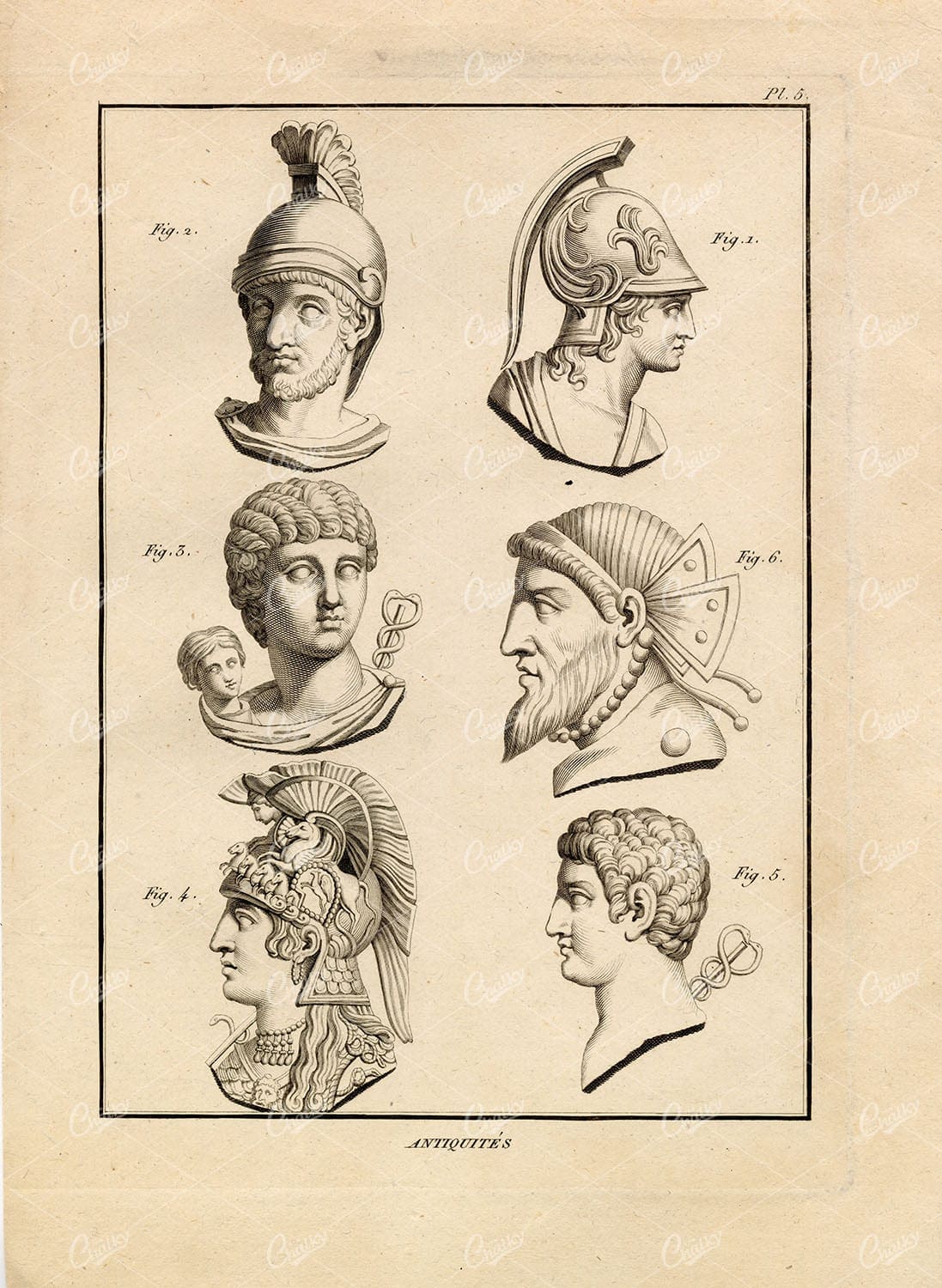

ROMAN & GREEK Gods Mars Mercury Morpheus Pallas – 1804 Copperplate Print
- License Info
- Resolution: 7572 x 10350 300dpi
- Year of Print: 1804
Related Images


PERSIA Wild Animals of Persians Heads & Paws – 1774 Print Copperplate
- License Info
- Resolution: 7844 x 10247 300dpi
- Year of Print: 1774
Related Images
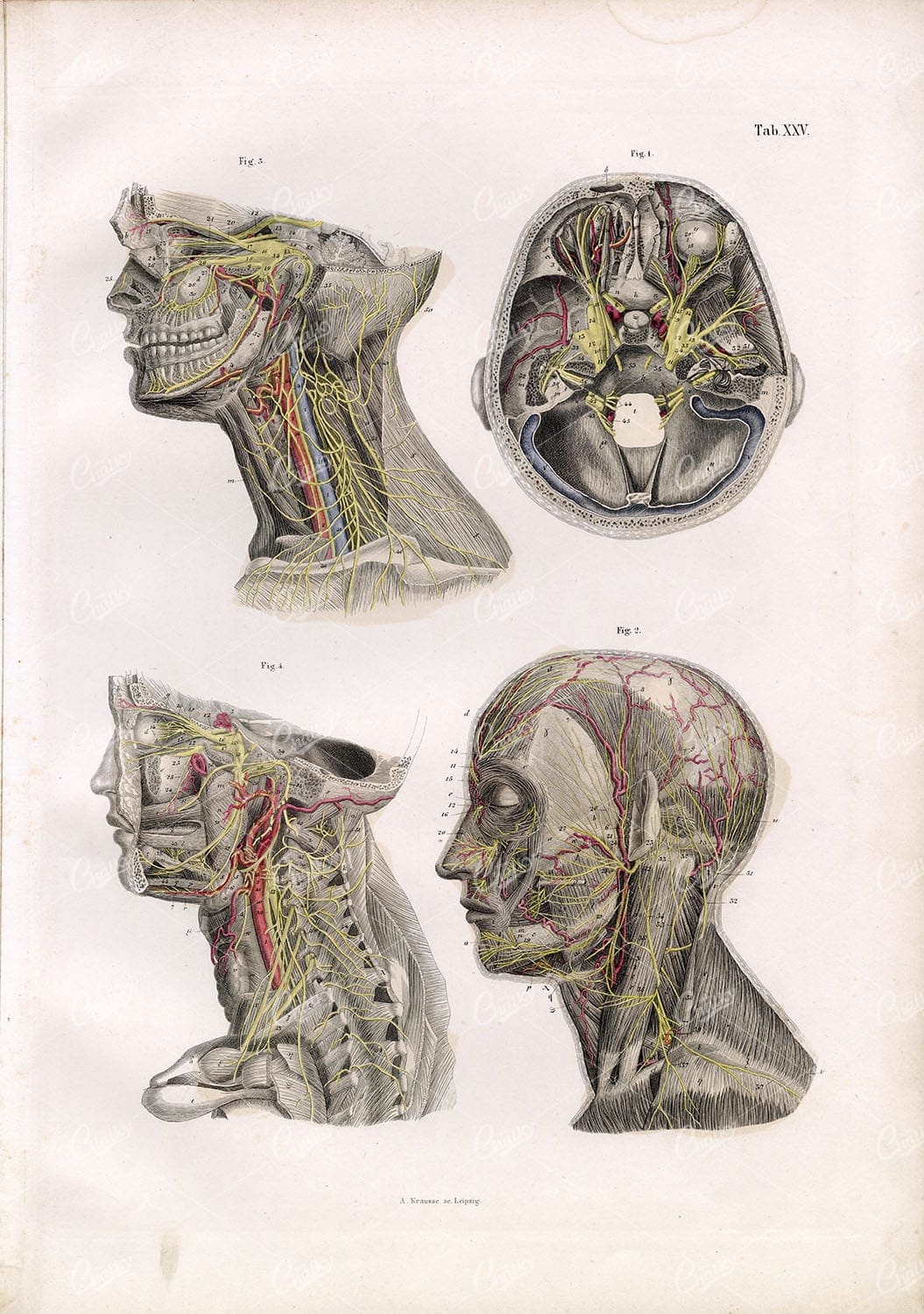

ANATOMY Bock Human Anatomy Stock Image – Nervous System Neck Head Nerves 1879
Original Colour Vintage Print from Lorenz Okenfuss' 'Oken's Naturgeschichte' (Allgemeine Naturgeschichte für alle Stände), with illustrations by Johann Susemihl (1767-1847), and published in Stuttgart by Hoffman between 1839 and 1841. Lorenz Oken (1 August 1779 - 11 August 1851) was a German naturalist, botanist, biologist, and ornithologist. Oken was born Lorenz Okenfuss (German: Okenfuß) in Bohlsbach (now part of Offenburg), Ortenau, Baden, and studied natural history and medicine at the universities of Freiburg and Würzburg. He went on to the University of Göttingen, where he became a Privatdozent (unsalaried lecturer), and shortened his name to Oken. As Lorenz Oken, he published a small work entitled Grundriss der Naturphilosophie, der Theorie der Sinne, mit der darauf gegründeten Classification der Thiere (1802). This was the first of a series of works which established him as a leader of the movement of "Naturphilosophie" in Germany.
- License Info
- Resolution: 11634 x 16420 300dpi
- Year of Print: 1843
Related Images


OKEN’S Naturgeschichte – Human Anatomy Artwork – Torso and Head
Original Colour Vintage Print from Lorenz Okenfuss' 'Oken's Naturgeschichte' (Allgemeine Naturgeschichte für alle Stände), with illustrations by Johann Susemihl (1767-1847), and published in Stuttgart by Hoffman between 1839 and 1841. Lorenz Oken (1 August 1779 - 11 August 1851) was a German naturalist, botanist, biologist, and ornithologist. Oken was born Lorenz Okenfuss (German: Okenfuß) in Bohlsbach (now part of Offenburg), Ortenau, Baden, and studied natural history and medicine at the universities of Freiburg and Würzburg. He went on to the University of Göttingen, where he became a Privatdozent (unsalaried lecturer), and shortened his name to Oken. As Lorenz Oken, he published a small work entitled Grundriss der Naturphilosophie, der Theorie der Sinne, mit der darauf gegründeten Classification der Thiere (1802). This was the first of a series of works which established him as a leader of the movement of "Naturphilosophie" in Germany.
- License Info
- Resolution: 11700 x 9500 300dpi
- Year of Print: 1836
- Artist: Lorenz Oken
- Image Type(s): JPG
From this collection
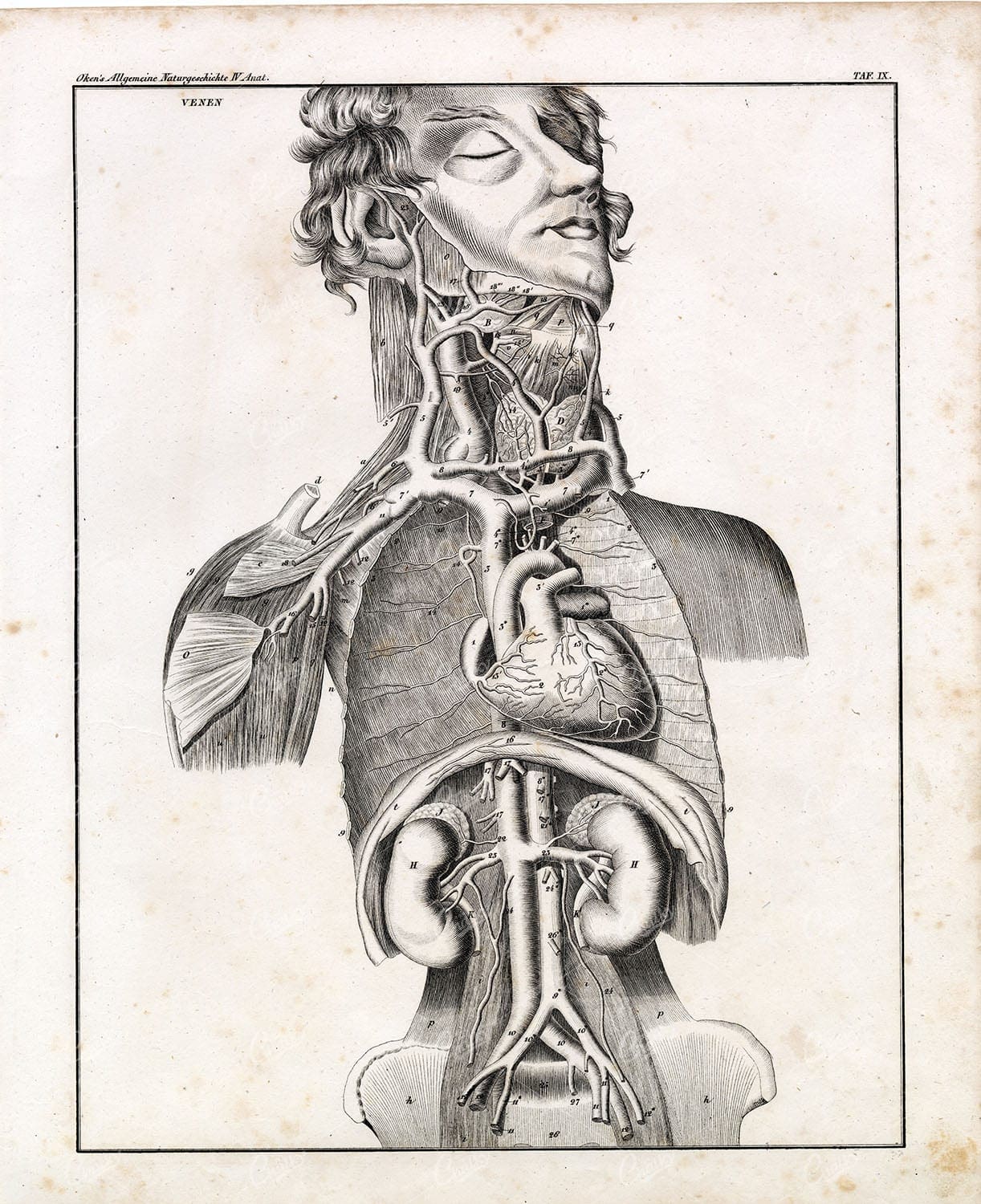

VINTAGE Human Anatomy Print – Antique Oken’s Naturgeschichte Artwork
Original Colour Vintage Print from Lorenz Okenfuss' 'Oken's Naturgeschichte' (Allgemeine Naturgeschichte für alle Stände), with illustrations by Johann Susemihl (1767-1847), and published in Stuttgart by Hoffman between 1839 and 1841. Lorenz Oken (1 August 1779 - 11 August 1851) was a German naturalist, botanist, biologist, and ornithologist. Oken was born Lorenz Okenfuss (German: Okenfuß) in Bohlsbach (now part of Offenburg), Ortenau, Baden, and studied natural history and medicine at the universities of Freiburg and Würzburg. He went on to the University of Göttingen, where he became a Privatdozent (unsalaried lecturer), and shortened his name to Oken. As Lorenz Oken, he published a small work entitled Grundriss der Naturphilosophie, der Theorie der Sinne, mit der darauf gegründeten Classification der Thiere (1802). This was the first of a series of works which established him as a leader of the movement of "Naturphilosophie" in Germany.
- License Info
- Resolution: 9500 x 11500 300dpi
- Year of Print: 1836
- Artist: Lorenz Oken
- Image Type(s): JPG
From this collection
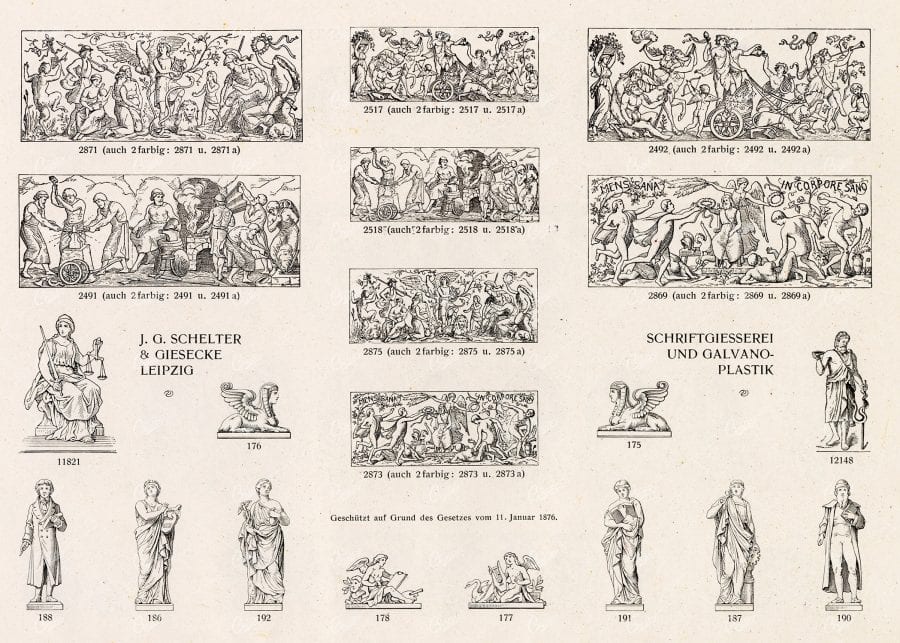
Support the Library
Our supporters and members help us continue collecting and restoring these wonderful pieces of art for the modern creator
Unlock Everything and Become a Member!
While a lot of the library is available for free, some is kept behind closed dusty doors only to be accessed by our lovely members.
